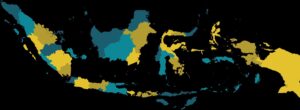8-DAY LANGTANG VALLEY TREK GUIDE (Syabrubesi-Kyanjin Gompa)
18 min readIf you’re looking for an incredible trekking experience in Nepal without having to take a flight or shell out a lot of money for expensive permits, then the 8-day Langtang...
The post 8-Day Langtang Valley Trek in Nepal: The Ultimate Guide appeared first on Bucketlist Bri.
If you’re looking for an incredible trekking experience in Nepal without having to take a flight or shell out a lot of money for expensive permits, then the 8-day Langtang Valley trek checks off all the boxes.
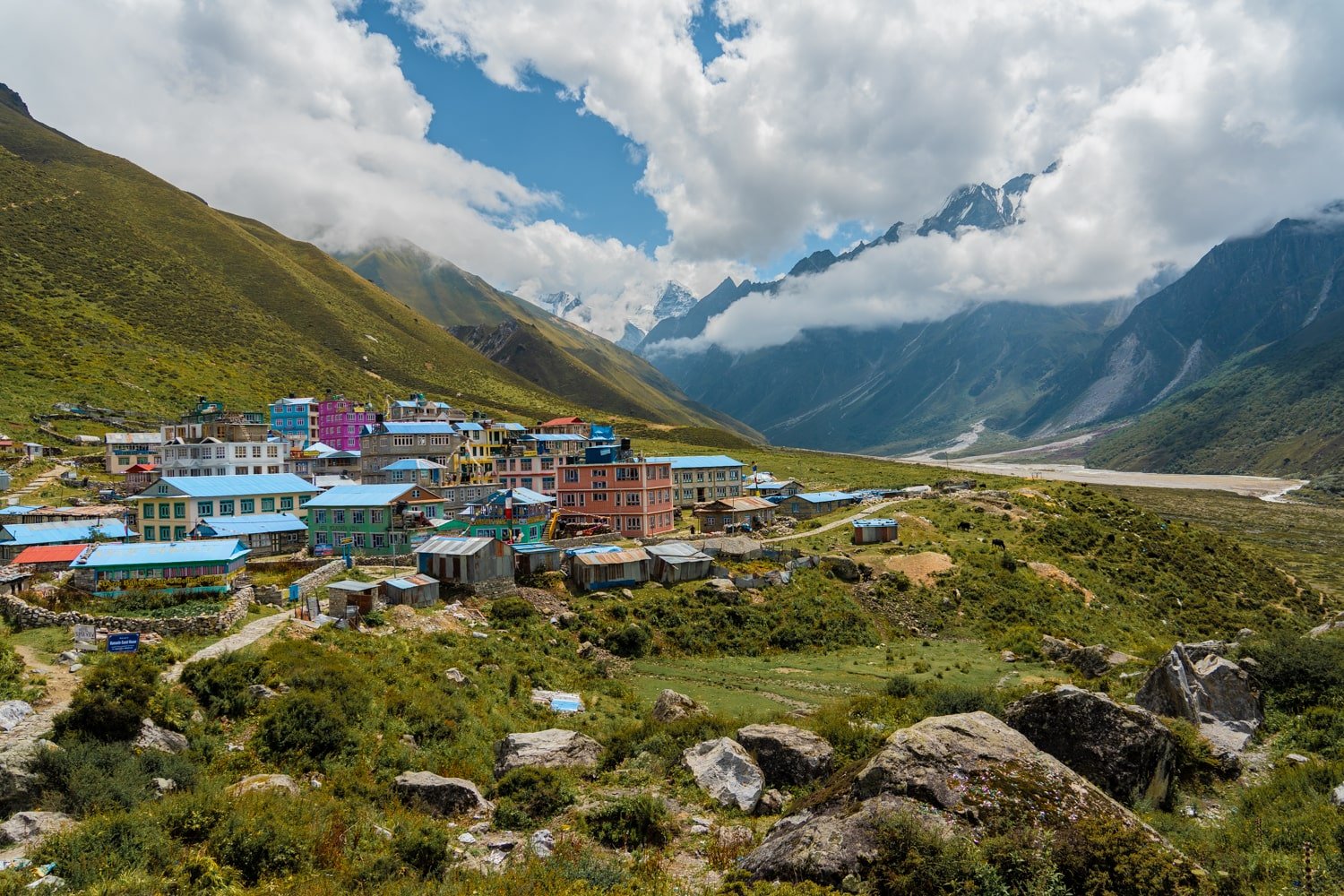
Disclaimer: This post contains affiliate links that may earn me a small commission should you decide to click through and make a valid purchase (at no extra cost to you). Thanks so much for your support!
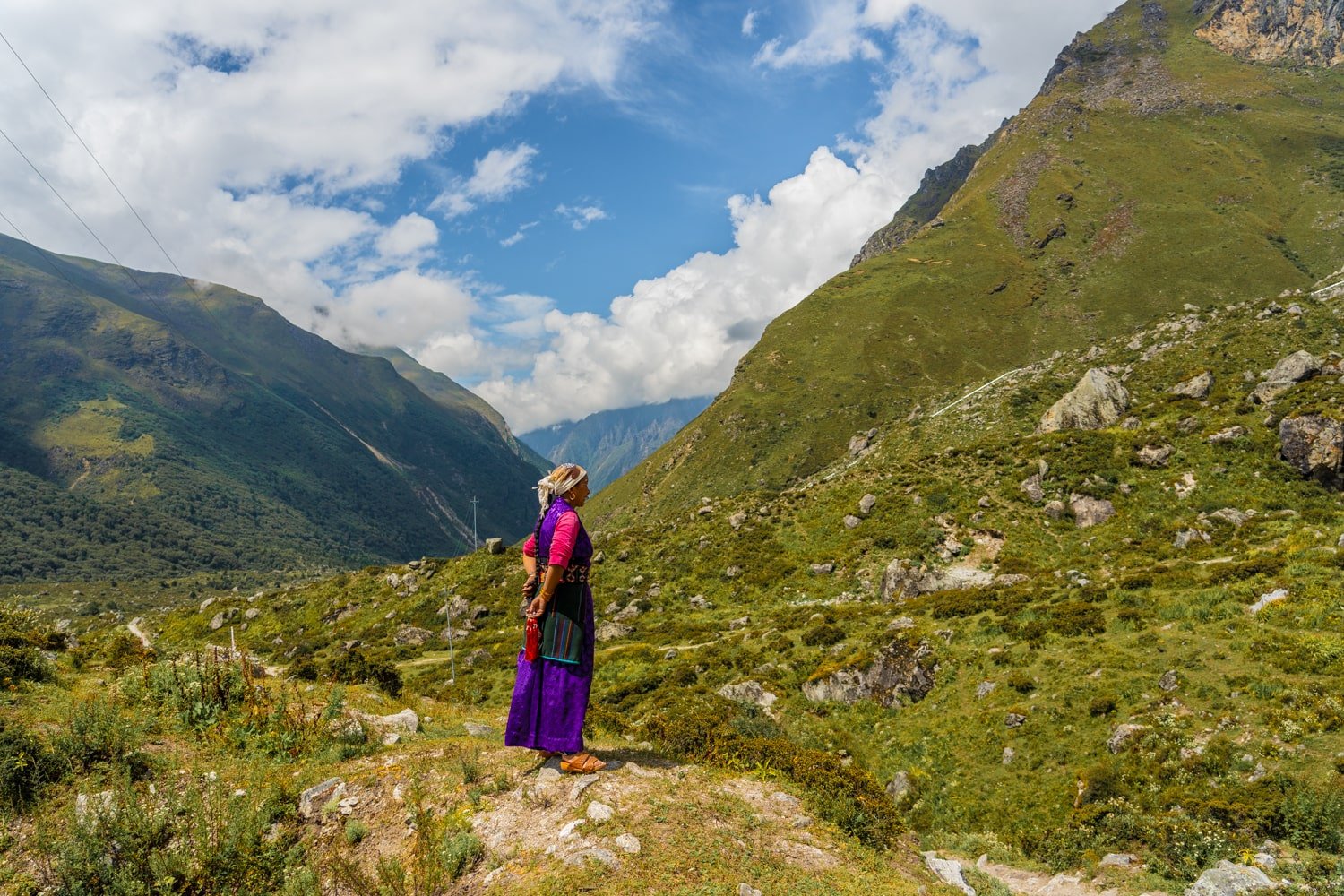
Langtang Valley takes six full days to trek from Syabrubesi to Kyanjin Gompa, but eight days total (for one day of transport tacked on at either end).
That said, Langtang is one of the more attractive short but moderately challenging treks you can do departing from Kathmandu.
There is so much to say about my Langtang trekking experience (which I’ll detail below in this guide), but for now, just know that it packs a punch in terms of value/time/reward.
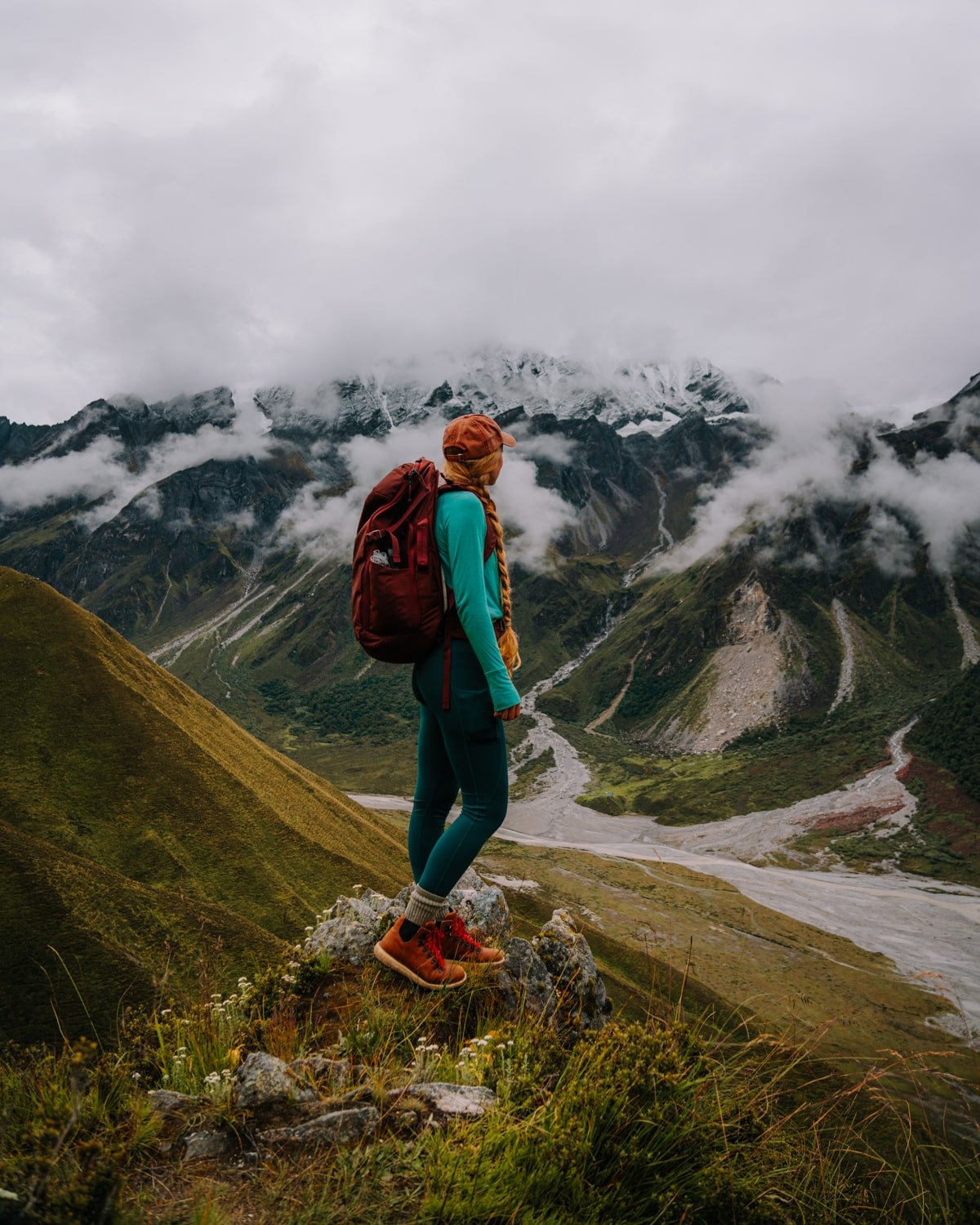
In less than one week on the Langtang trek, you will hike from 1460m in elevation up to 4984m, at the top of Tserko Ri—one of the two viewpoints you can reach from Kyanjin Gompa on out-and-back day trips—and, in total, you will trek approximately 80km / 50 miles.
During this time (and depending on which season you go), you will get to see the beauty and diversity of the Langtang Himalayas—from remote Tibetan villages to fuzzy yaks to cascading cliffside waterfalls to wildflower-strewn meadows to glaciers, and more.
Not to mention, the Langtang mountain range is stunning!
From Tserko Ri, in particular, you have the chance at unhampered 360-degree views of around twenty snow-capped peaks standing at a height of over 6000-7000m.
Ultimately, the Langtang Valley Trek is a fairly short yet gorgeous trek that is ideal for all levels.
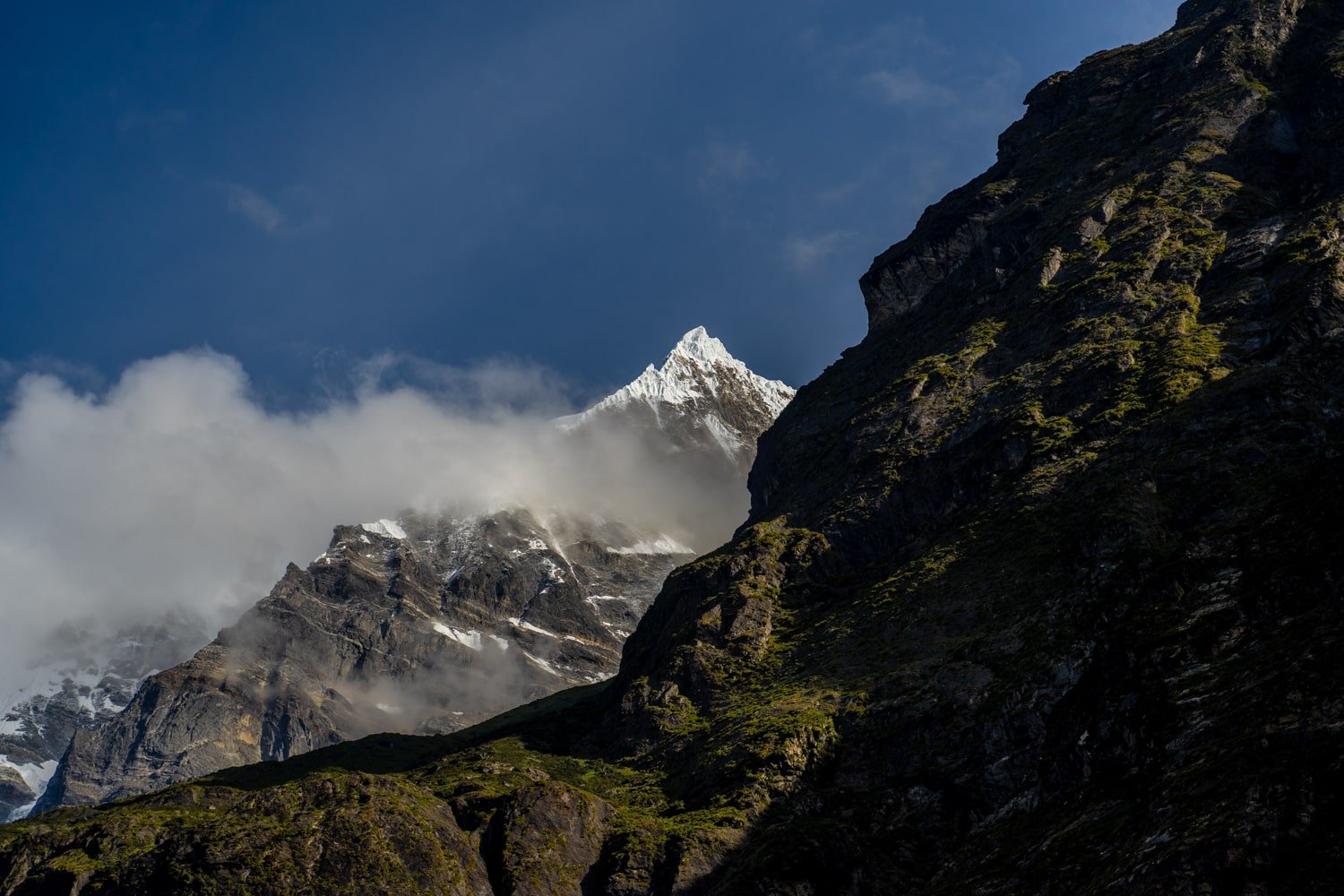
Having previously trekked to Annapurna Base Camp, I felt that Langtang offered a unique experience and I’d definitely recommend it, especially for first-time trekkers in Nepal who want to base out of Kathmandu.
As you may know, Langtang village was completely lost to the landslides of 2015, so by visiting you are directly helping the communities of Langtang rebuild—just another reason to add Langtang Valley to your trekking bucket list!
If you’re still deciding on whether this trek is right for you or not, read more below!
In this post, I share everything you need to know about the Langtang Valley Trek.
show
The Complete Guide: Langtang Valley Trek in Nepal
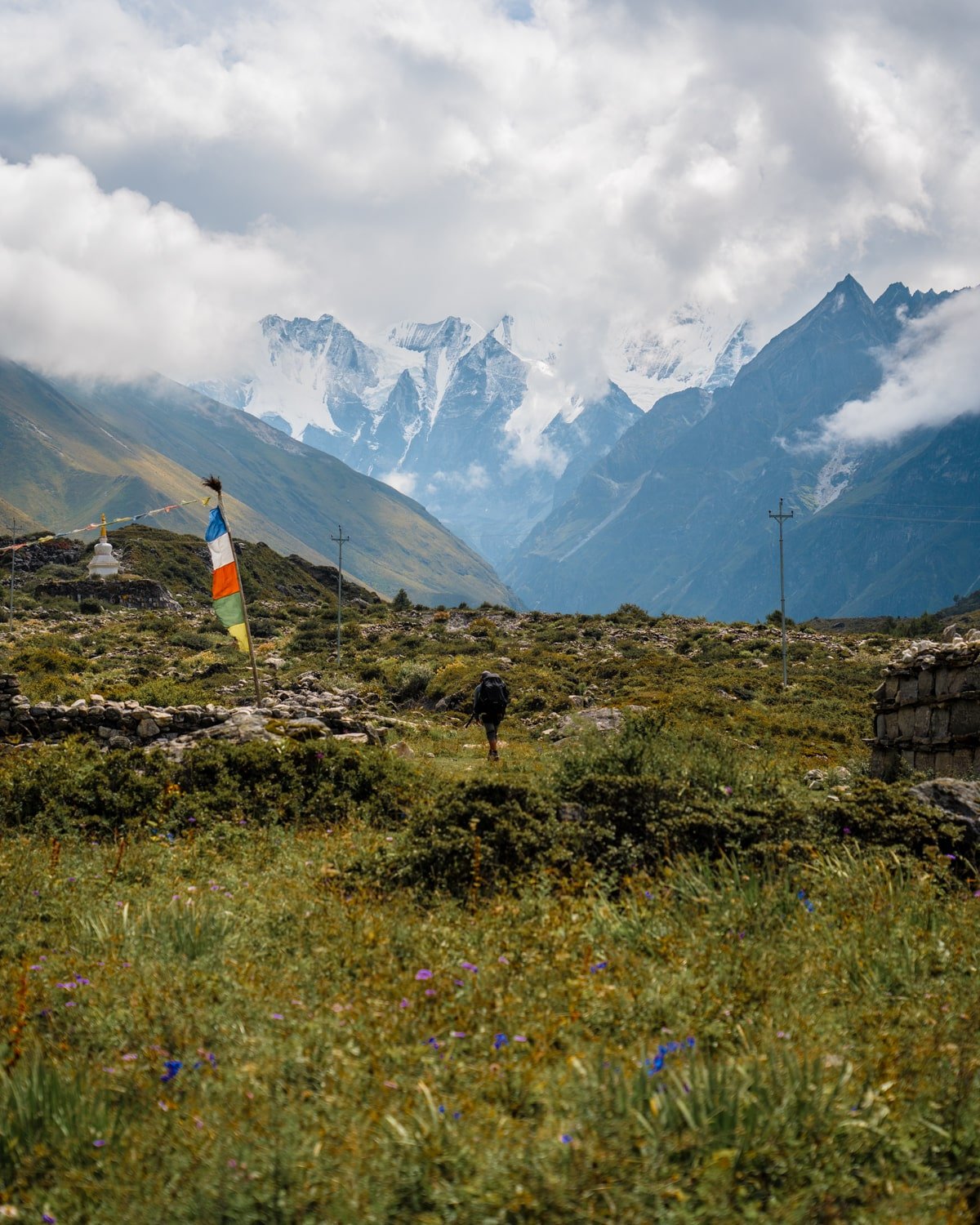
What to Know: Langtang Valley Trek FAQs & Tips
Do you need a permit for the Langtang trek?
Yes! You will just need to pay a TIMS fee ($15 for SAARC, $30 for foreigners) and show your passport at the checkpoint to enter Langtang National Park.
You can do all of this on your way to the starting point of the trek in the village of Syabrubesi.
Do you need a guide or porter to go trekking in Langtang Valley?
You can do the Langtang Valley Trek from Syabrubesi to Kyanjin Gompa and back without a guide or porter.
However, whether you are trekking solo or in a group, having a guide can seriously change your experience by adding an extra layer of security and peace of mind.
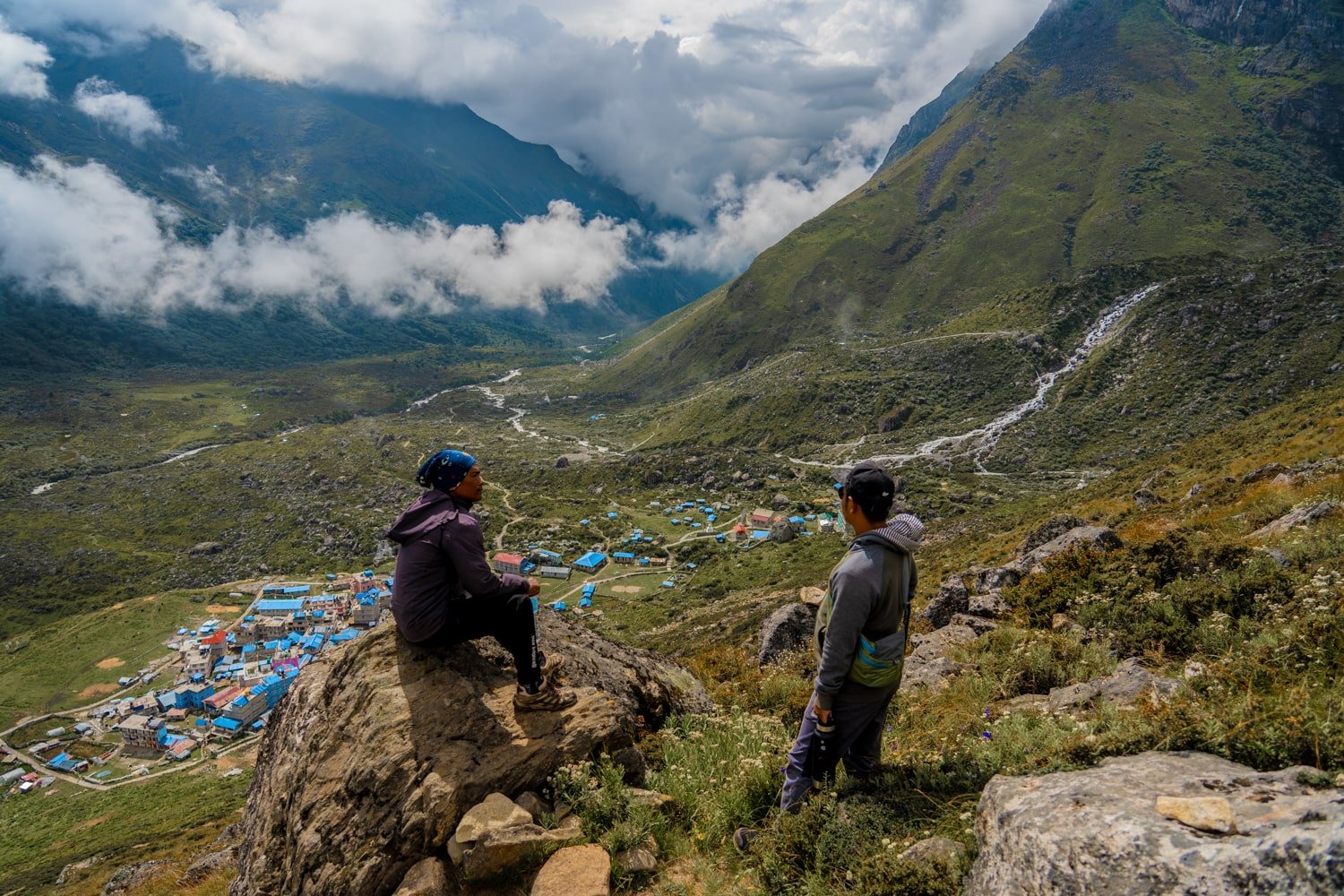
Can you drink the water in Langtang Valley?
You can drink the water in Langtang but you need to filter it first to make it safe for consumption.
Instead of buying plastic bottles along the trek, you can fill up your reusable water bottle from the rivers and water spouts in the villages.
Don’t forget you need water purification tablets/drops and/or a water bottle with a LifeStraw filter or a Katadyn BeFree bottle in order to safely drink the water.
I used my Hydroflask water bottle paired with a personal Lifestraw filter—and I lived to tell the tale!
Note: I picked up the LifeStraw filter in Thamel (I think I paid 2000-2500 Rs) before my trek. I couldn’t find a Katadyn, so get that or a LifeStraw Squeeze before you come if that’s what you’d prefer.
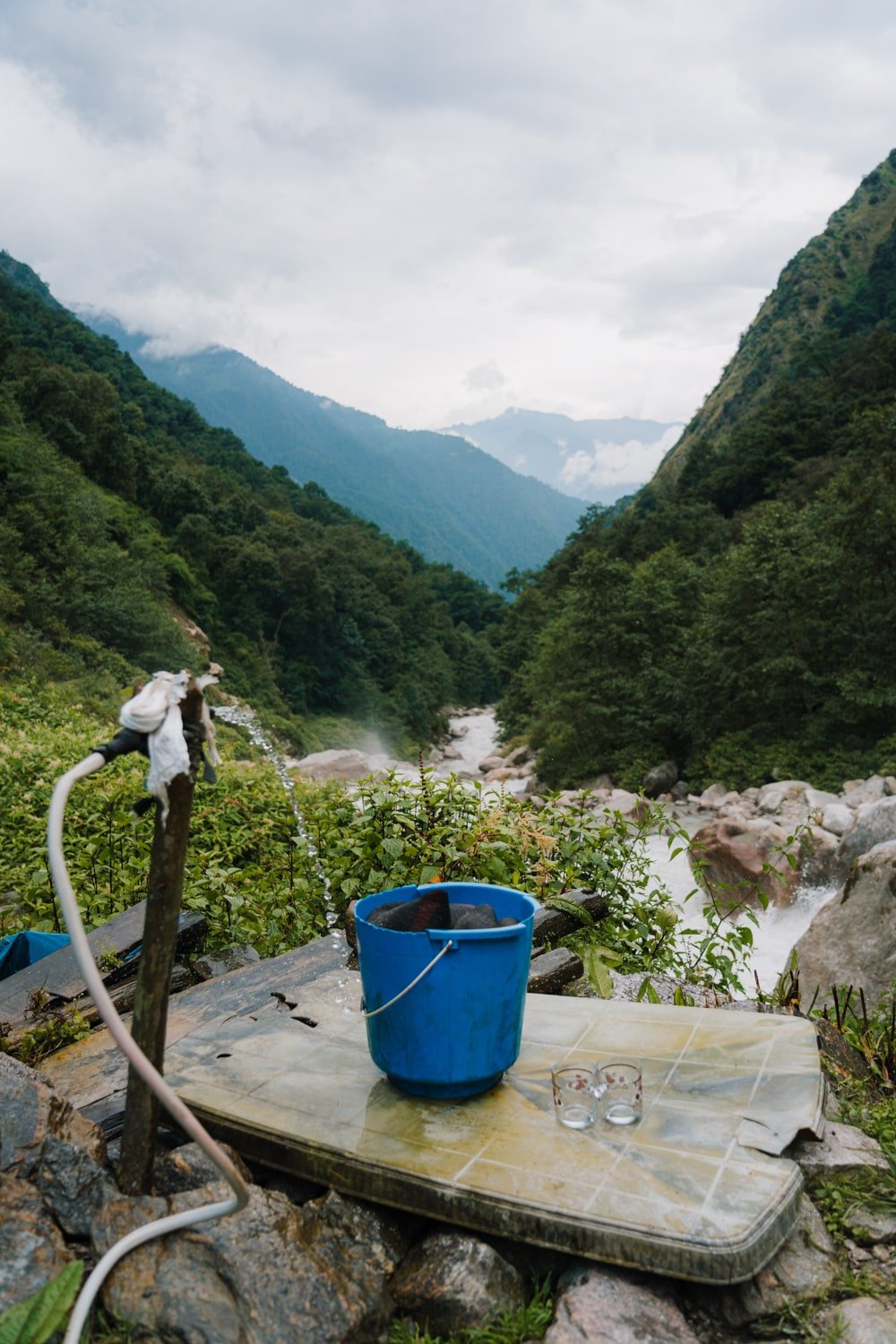
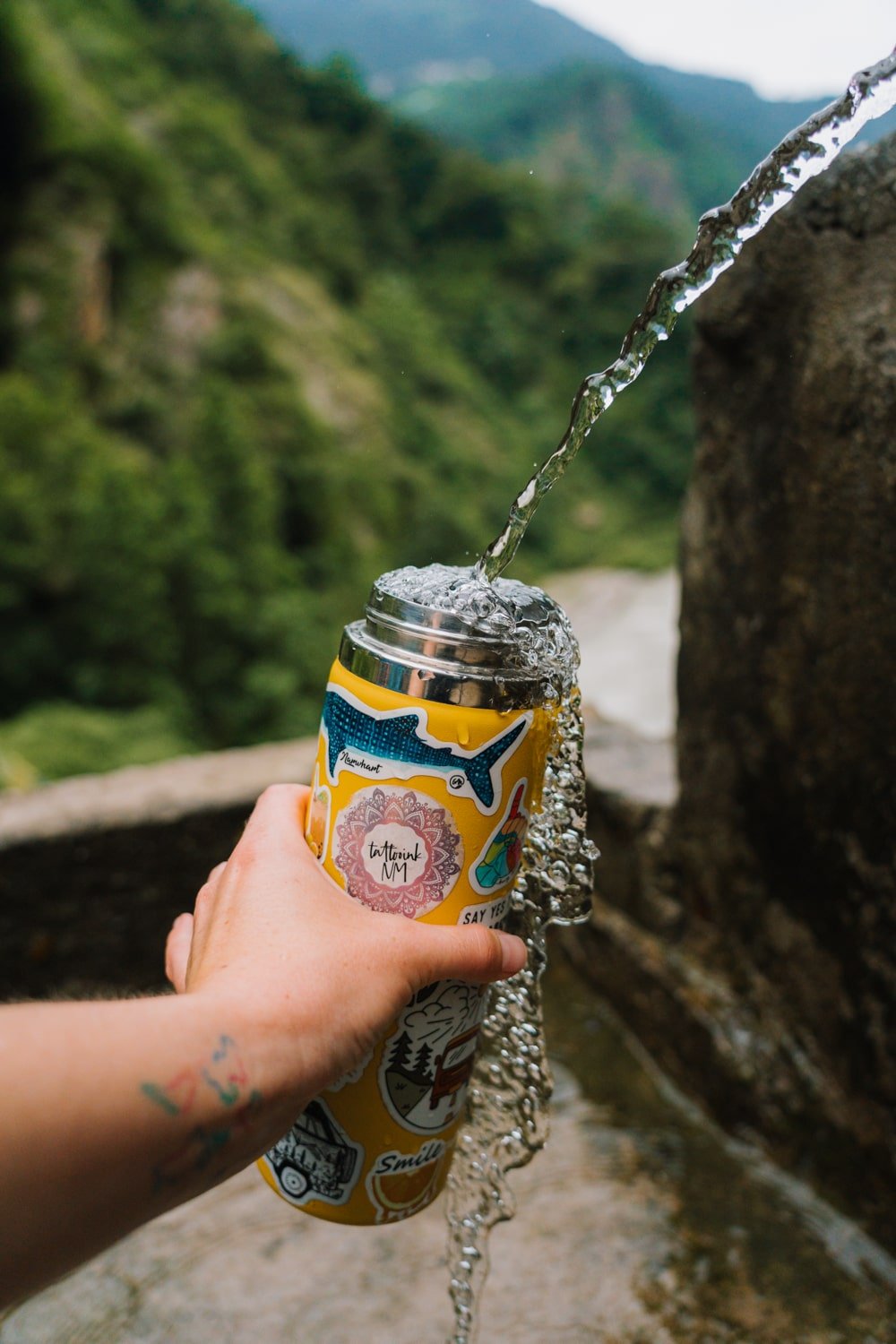
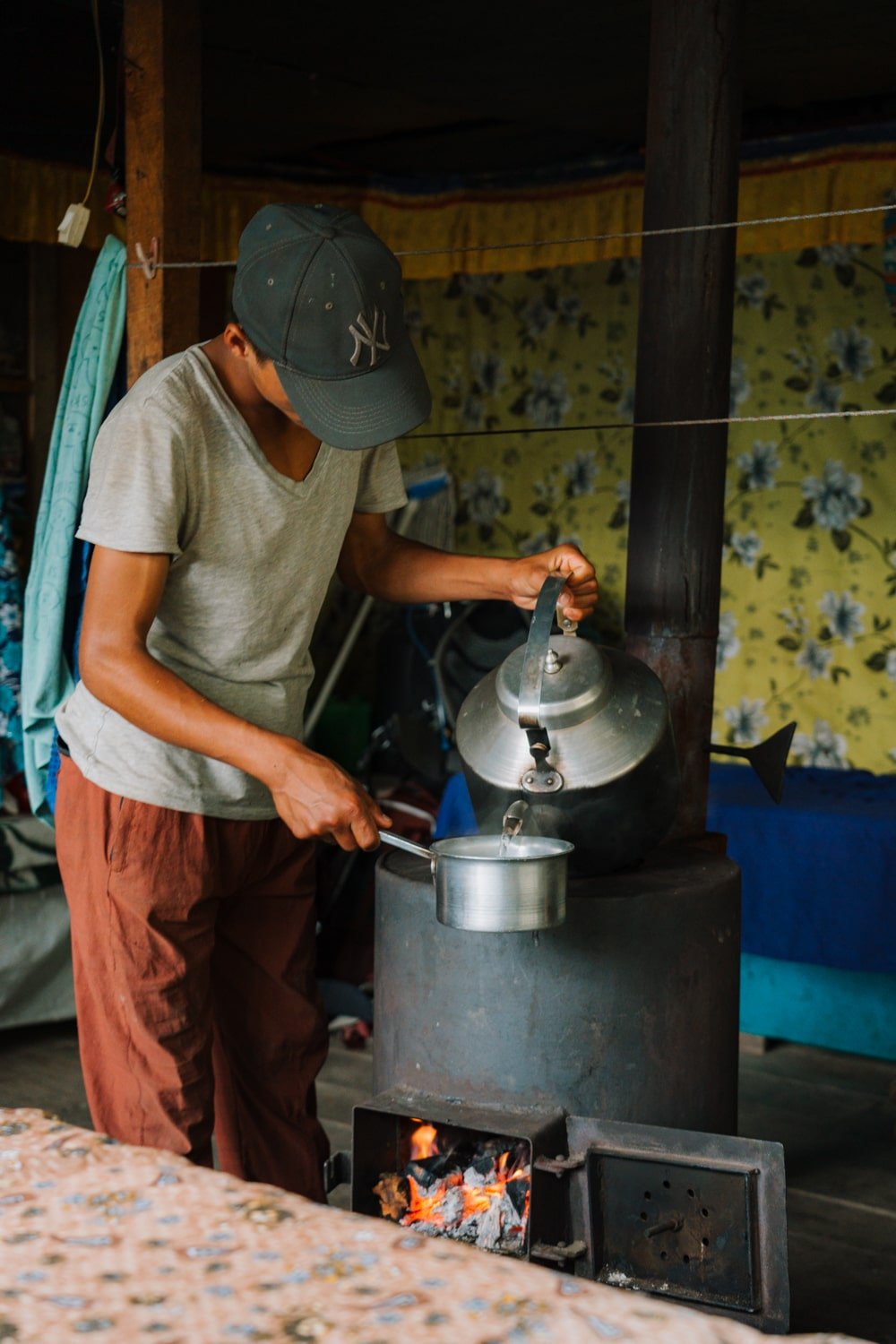
When is the best time to trek in Langtang?
The best time to do the Langtang Valley trek is after the summer monsoon season.
From mid-September through November when days are dry, clear, and not too hot or cold, is best for a Langtang trek.
Will it snow on the Langtang trek?
It depends on when you go!
If you go in spring, then it’s likely there will be snow on the trail. I did the Langtang Valley trek in early September, just after the monsoon season. And we did get a few cloudy skies and rainy afternoons.
Also, the days on the trail were warm and humid at lower elevations while crisp and cool at higher elevations.
Again, the best months to trek in Langtang are October–November when the weather and temperature are drier, clearer, and milder. See below for my packing list tips!
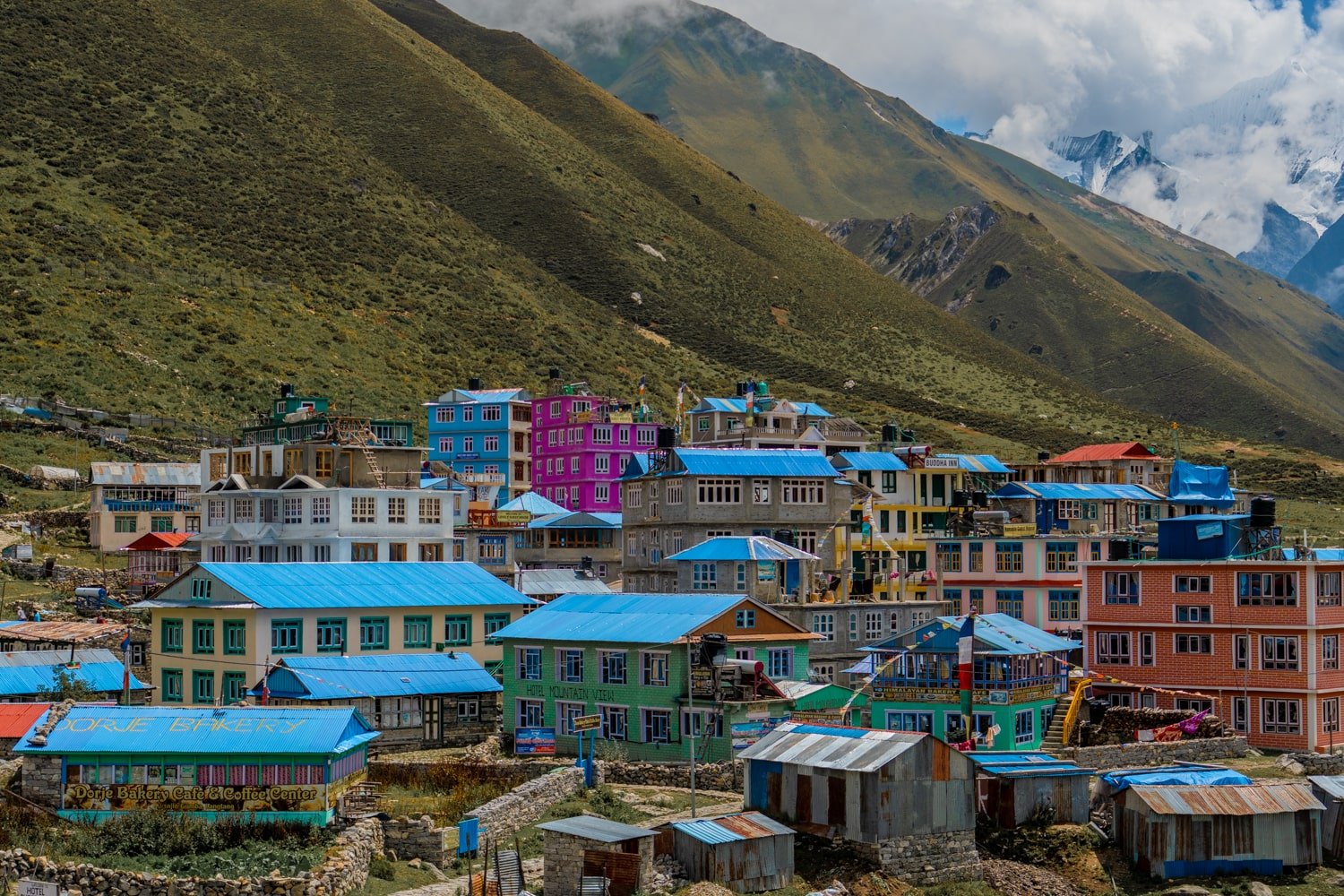
How Much Does It Cost to Do the Langtang Valley Trek?
Cost for a Trekking Guide/Company
Most of the trekking companies offering an 8-day Langtang Valley Trek like this one cost between $500-800 USD per person.
That excludes optional porters for bags, private jeeps for hire, medical insurance, and tips.
Inclusions of organized trips for the Langtang Valley trek will cover your food (breakfast, lunch, dinner), lodging (shared accommodation), national park fees, and public transport (roundtrip bus fare).
With this in mind, you should still budget $10-15 USD per day (about 1000-1500 Rs) for the Langtang trek (or about $80-$100 USD for eight days).
Extra purchases outside of what is included (for additional drinks, supplies, tips, etc.) will be your responsibility to cover.
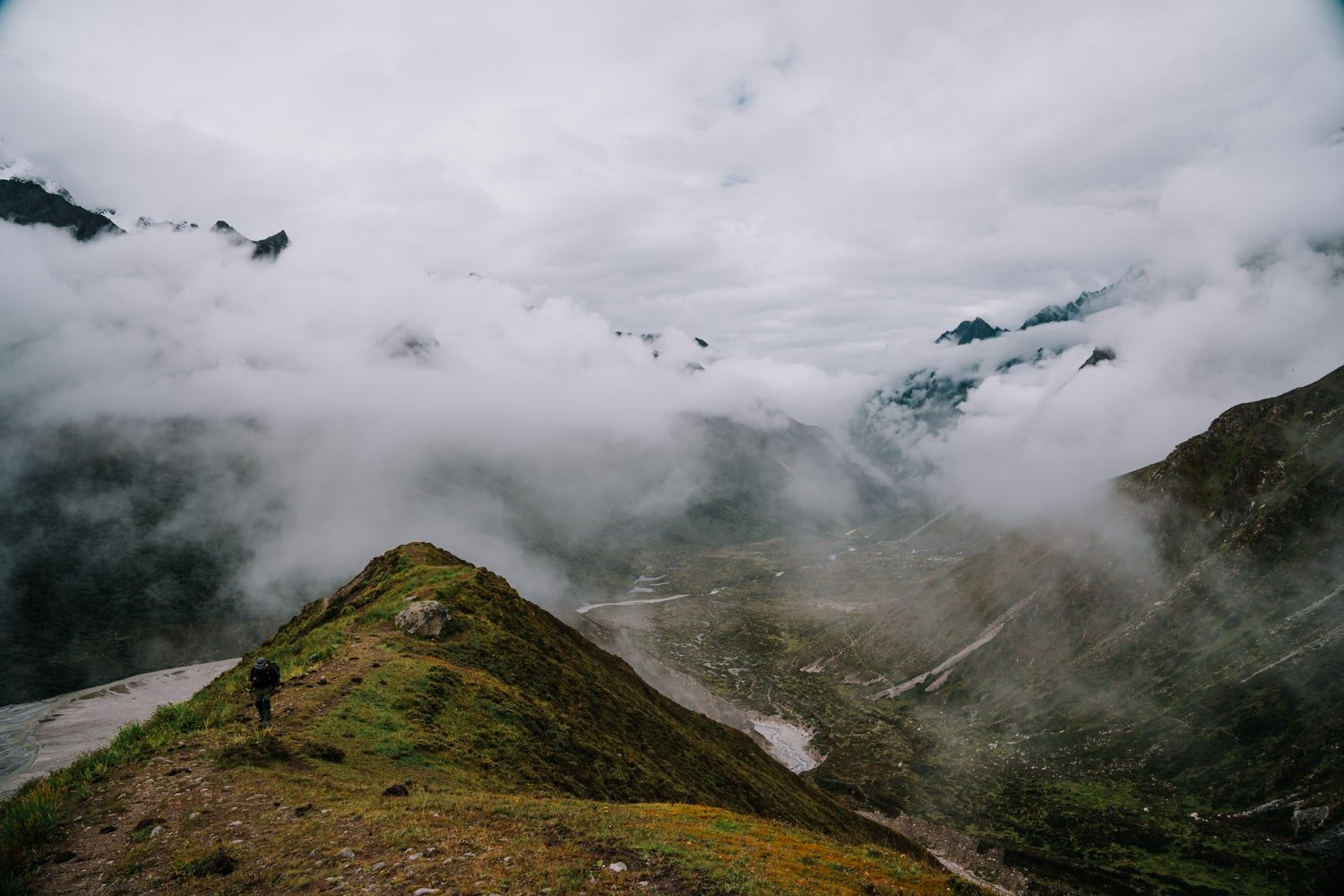
I chose to do my Langtang Valley Trek with Magical Nepal and I highly recommend them! My guides were Dilman and Lekh and my trekking roommate also hired a porter, Mr. Birendra. I felt very cared for and supported by all of them!
Cost to Trek Langtang Without a Guide
Now, if you want to trek Langtang entirely on your own, you should carry extra cash.
There is an ATM in Syabrubesi but I would not rely on it, so take out all the rupees you may need while in Kathmandu.
- $30 USD / 4000 Rs for the Langtang National Park fee (foreigners, $15 for SAARC nationals)
- $20-25 USD / 2000-3000 Rs for your roundtrip bus fare from Kathmandu-Syabrubesi (or for a private jeep back to Kathmandu from Syabrubesi, if available, 5000 Rs per person)
- $10-15 USD / 1000-1500 Rs spare cash per day for food/supplies if you go with a company, or roughly $30 USD / 4000 Rs per day if you organize the trek on your own
Here are examples of the prices I saw on the Langtang Valley Trek:
- Food: 500-900 Rs for most large dishes such as dal bhat, chow mein, and soups.
- Drinks: 150-400 Rs for milk teas, coffees, etc. Beer costs around 600 Rs.
- Single bed in shared twin bedroom: 500-1000 Rs per night
- Wi-Fi/electricity or hot showers (where applicable): 500-1000 Rs
Note that the cost of food/drink and accommodation increases slightly along the Langtang route, as you reach more remote teahouses and villages.
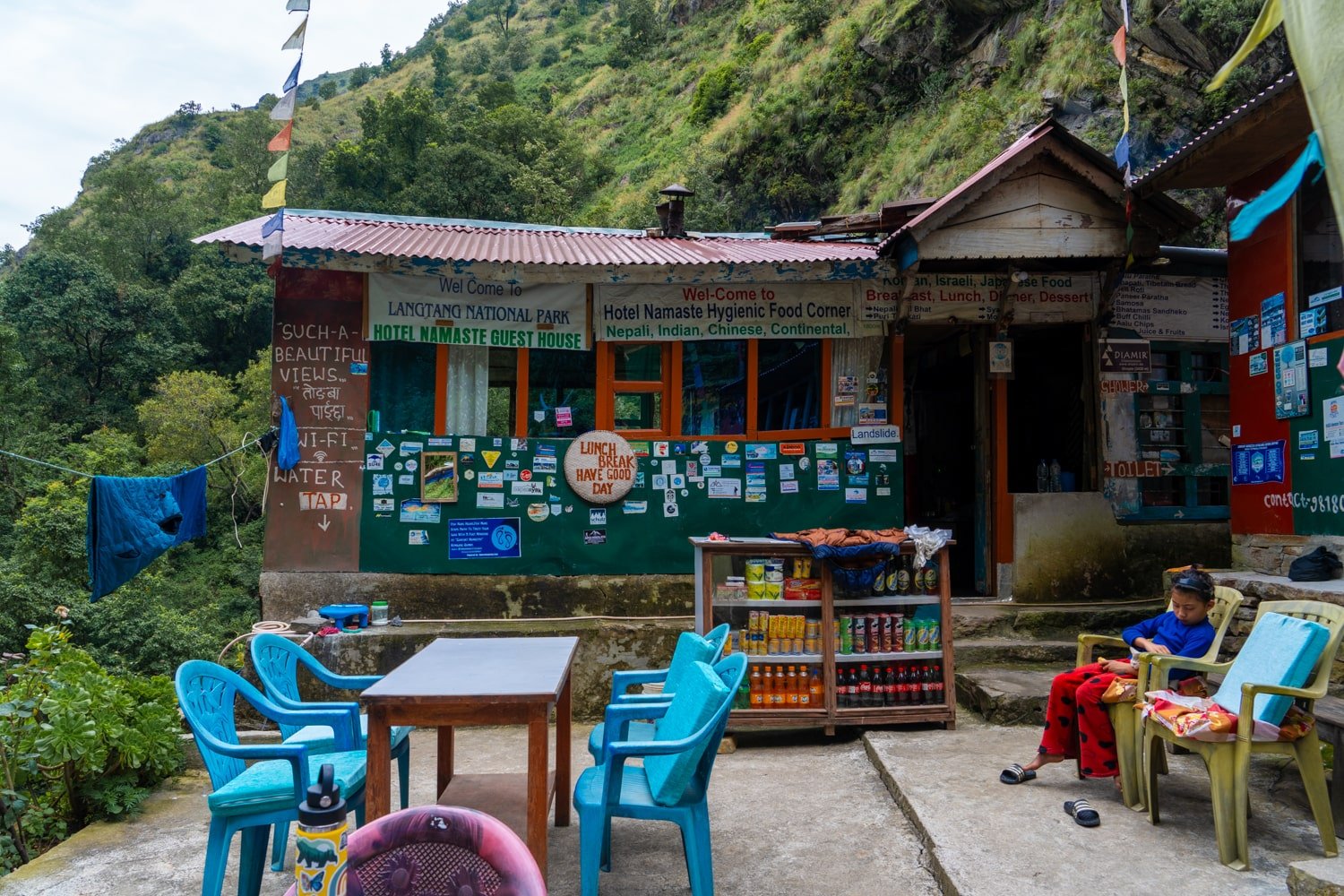
Also, keep in mind that prices might have increased since my trek, and you should plan to take extra funds in case of an emergency.
A final note about organizing a Langtang trek without a guide:
Make sure to plan ahead!
You might need to call a few teahouses in advance to secure your spot, especially during the high season from October onward, as trekkers are going up but also coming back down through the same villages.
What to Pack & Wear for the Langtang Valley Trek
When you go to pack your backpack for your Langtang trek, just remember: Pack layers and pack light!
Everything you pack you have to carry (unless you hire a porter), so pack minimally and intentionally.
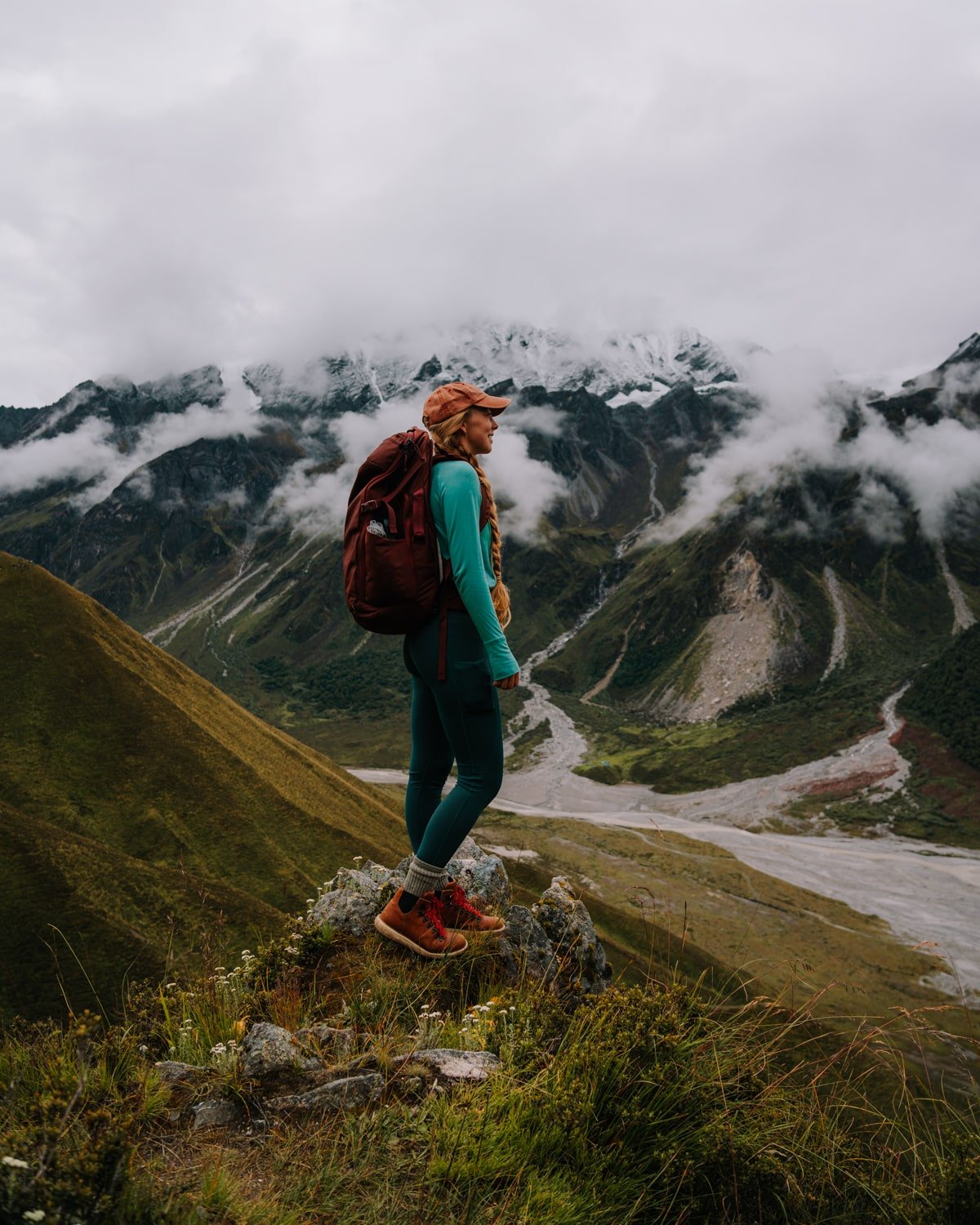
The general guidelines for how much your backpack should weigh say you should carry no more than 20% of your body weight.
You don’t need much on short Nepal treks like Langtang because you have teahouses, so it’s not like you’re carrying your food or sleeping gear.
Aim to pack light, so no more than 10-13 kg for the Langtang trek.
As the temperatures of the Langtang trek vary because of the 3000+m difference in elevation, you will need to pack a variety of light-warm clothes (season-pending).
That said, keep in mind that the below packing list for Langtang is based on my personal experience and is ideal for the months of September and October.
If you go in winter or spring, Langtang will have snow and the trek experience will be very different, so what you’d need to pack will change too.
Below is everything I packed for this 8-day trek in early September!
Langtang Trek Packing List
CLOTHES
- 3x trekking/yoga pants (I took 2 with pockets for my phone!)
- 1-2x “clean” outfits for evenings in the teahouses, and the bus to Langtang and back
- 1x sweatpants
- 2 pairs of wool socks + 1 comfy evening socks
- 1x light puffer jacket
- 2x fleece jackets (light-medium warmth)
- 2x long-sleeves
- 1x rain jacket (I wore my Patagonia Torrentshell 3L jacket in wool white and LOVED it)
- 3x active crop-tops
- 3x short-sleeve shirts
- 1x hiking boots and 1x casual shoes (I wore my Danner hiking boots plus my Birkenstocks with socks for evenings)
I felt like I packed just the right amount of activewear for six days of trekking and two days of traveling, but feel free to customize this to your needs!
The first days of the trek/sections of the trail at lower elevations can feel hot and muggy, so on those days I’d take off my shirt and have only an active crop top on.
At higher elevations, I’d wear a crop top, long-sleeve, and then have my zip-up puffer or rain jacket on at the start which I shed later.
Also, I highly recommend packing a clean, non-trekking outfit or two to snuggle up in at the teahouses and for the journey from/to Kathmandu.
GEAR
- 40L REI backpack with Cotopaxi packing cubes
- Trekking poles — optional, but I highly recommend picking up one or two before the trek
- Knee brace — also optional, but I needed this desperately for those descents and luckily my guide carried an extra!
- Hat, sunglasses
- Hydroflask reusable water bottle (in hindsight, I wish I had packed an extra 1L Katadyn BeFree bottle)
- LifeStraw bottle (take water purification tablets as backup)
🎒 BACKPACK RECOMMENDATION 🎒
My 40L REI Recycled Ruckpack was perfect for this trek!
The waist and shoulder belts were so helpful in distributing the weight properly, and the size was ideal for this multi-day trek. I use it to move countries and take it often as my carry-on.
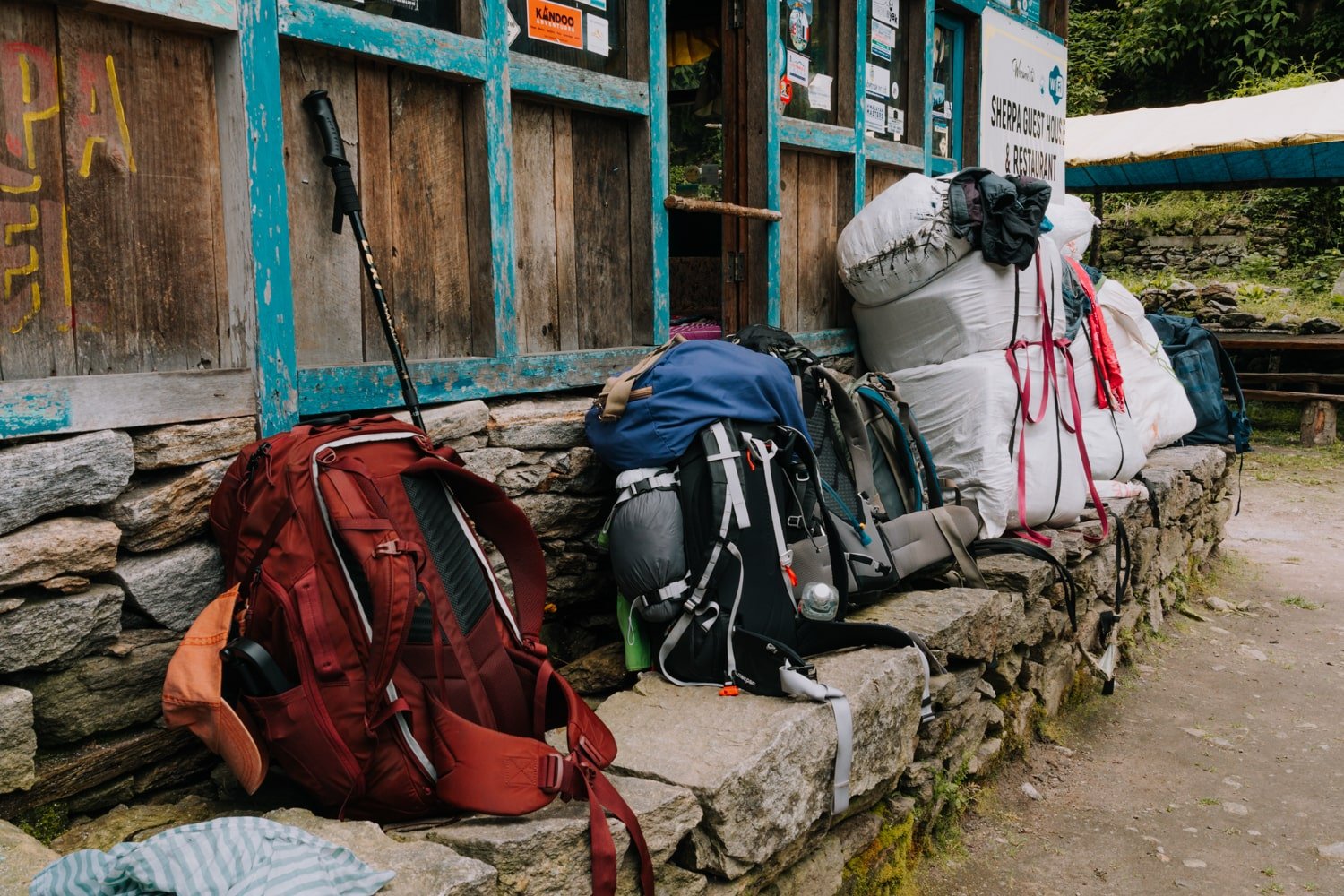
TOILETRIES
Toiletries and other items you may need to pack for the Langtang Valley trek include:
- Quick drying towel (most teahouses don’t provide towels, I had to use the host’s a time or two)
- Basics (shampoo bar/soap, deodorant, toothbrush/paste, hairbrush)
- Eye contacts/glasses, personal medications, etc.
- Chapstick + face lotion
- Pocket tissues
- Pack of body wipes (my Burt Bee’s wipes came in clutch)
- Hair ties/clips
- Sunscreen (this tin from Raw Elements is my favorite for travel)
- Bug spray — optional
- Blister kit, bandaids — optional
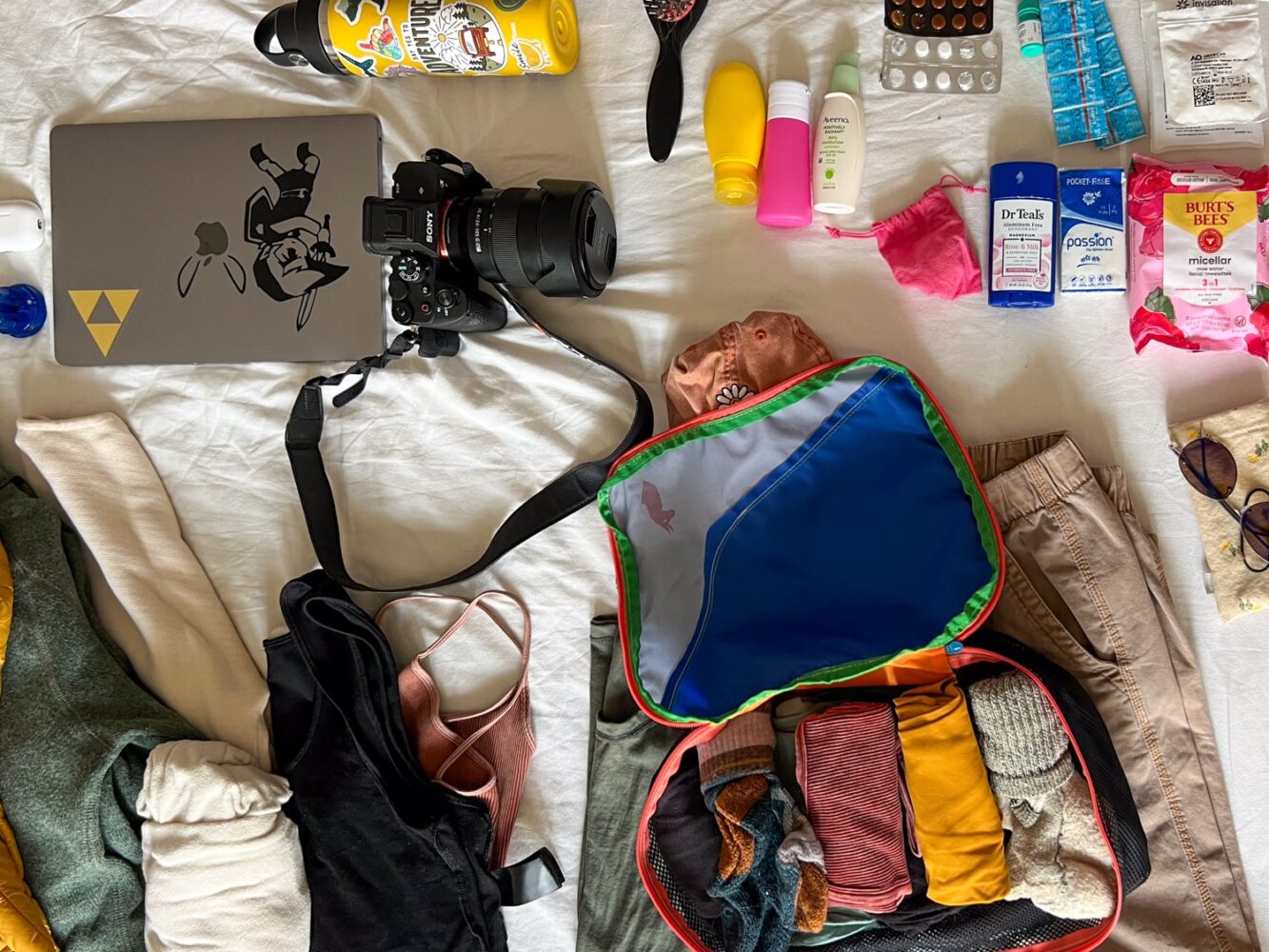
ELECTRONICS & OTHER
- Solar portable battery pack (definitely take this as electricity in the Langtang villages/teahouses isn’t a guarantee!)
- Phone + charging cables
- Camera — I took my Sony A7IV paired with the 25-104mm F/4 G lens
- Journal or book — I packed my Kindle and journal both for those lovely quiet evenings in the teahouses
- Airpods/earphones for the bus ride when you want to tune out the blaring road or bus music!
📸 If you take a camera, I HIGHLY recommend getting a convenient camera clip like mine for your backpack.
Langtang Trek Map
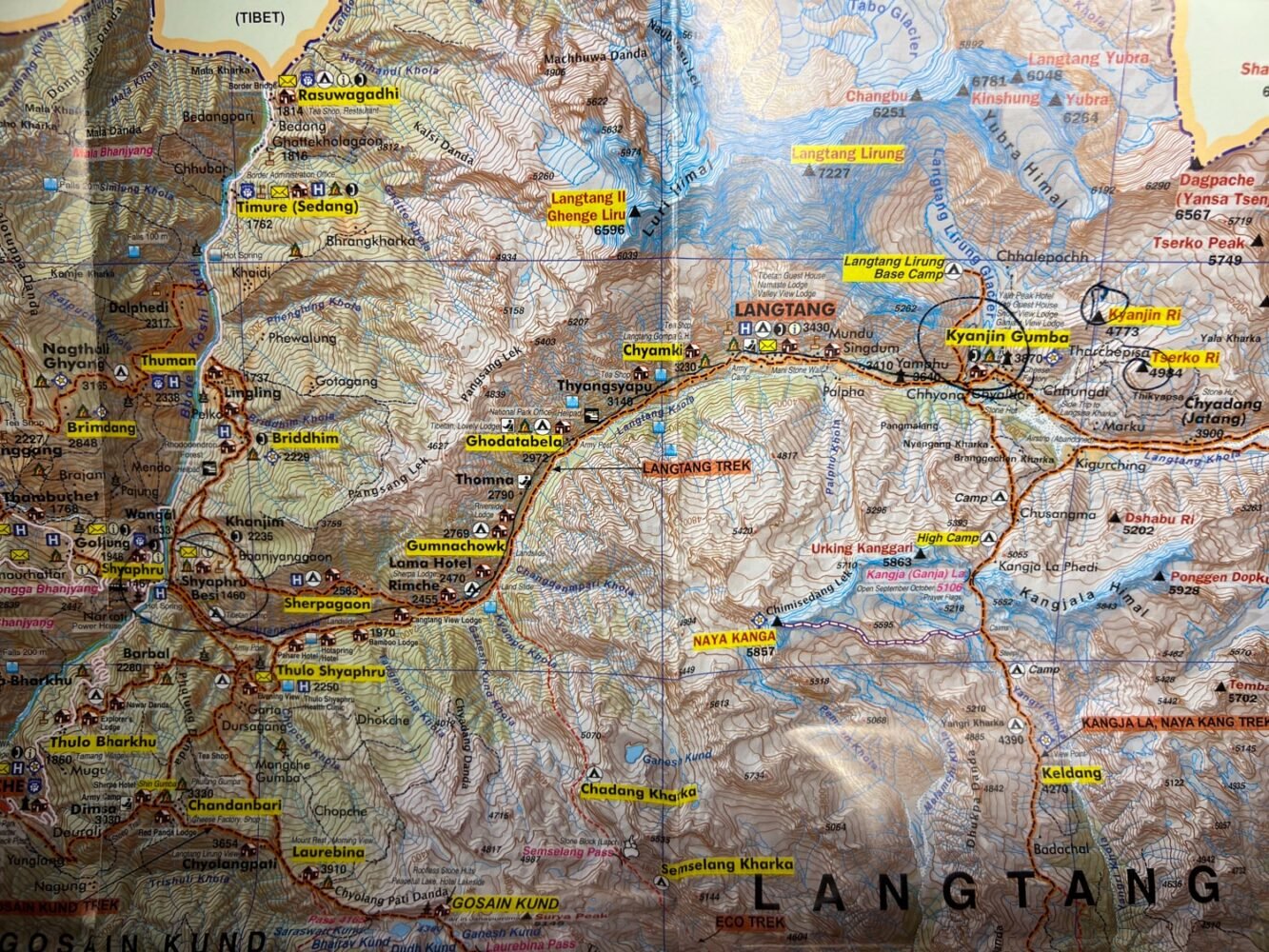
Our 8-Day Langtang Trekking Itinerary
Day 1: Kathmandu to Syabrubesi
- Route: Kathmandu (1400m) to Syabrubesi (1460m)
- Time: 7-9 hours by bus
- Road distance: 110 km / 68 miles
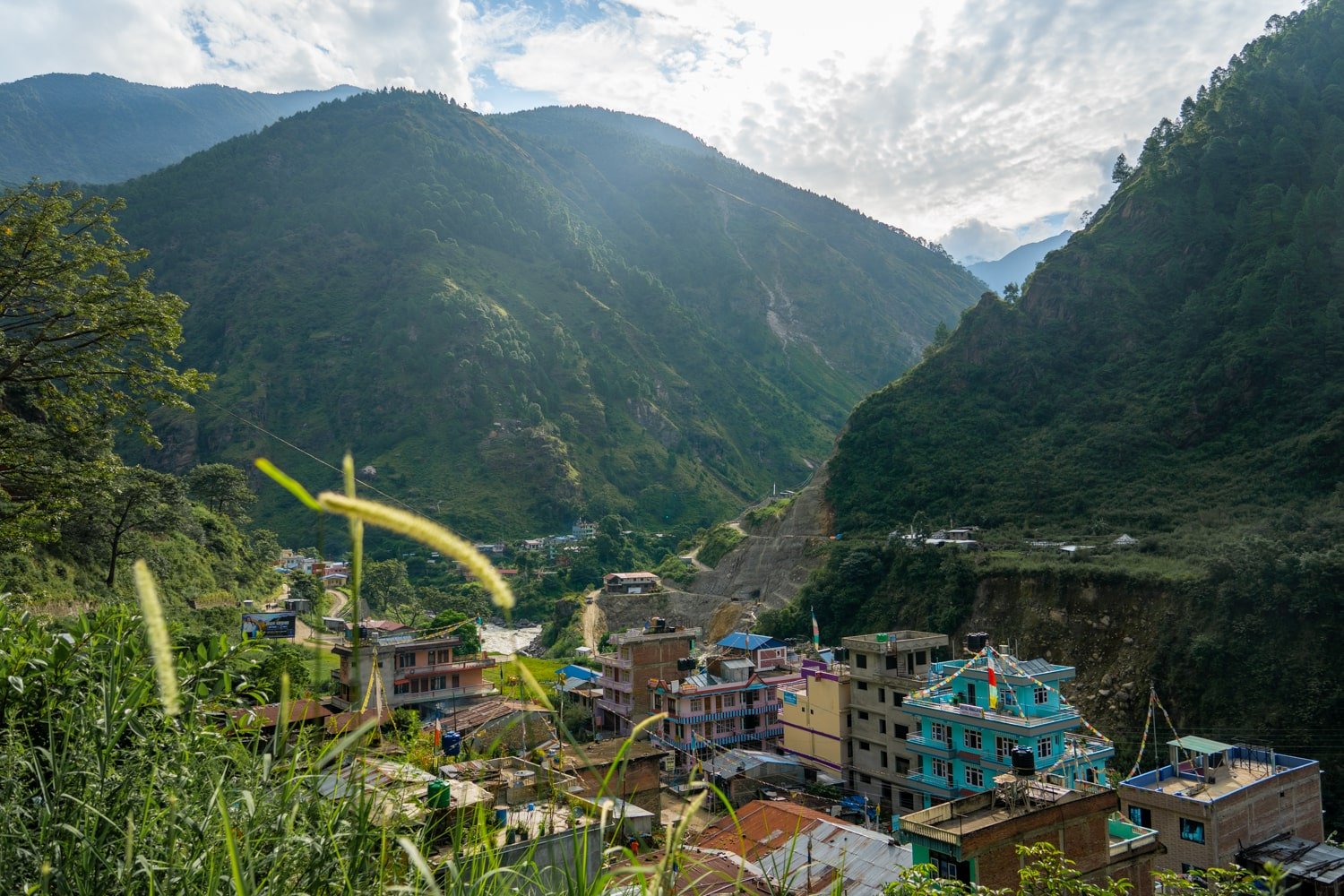
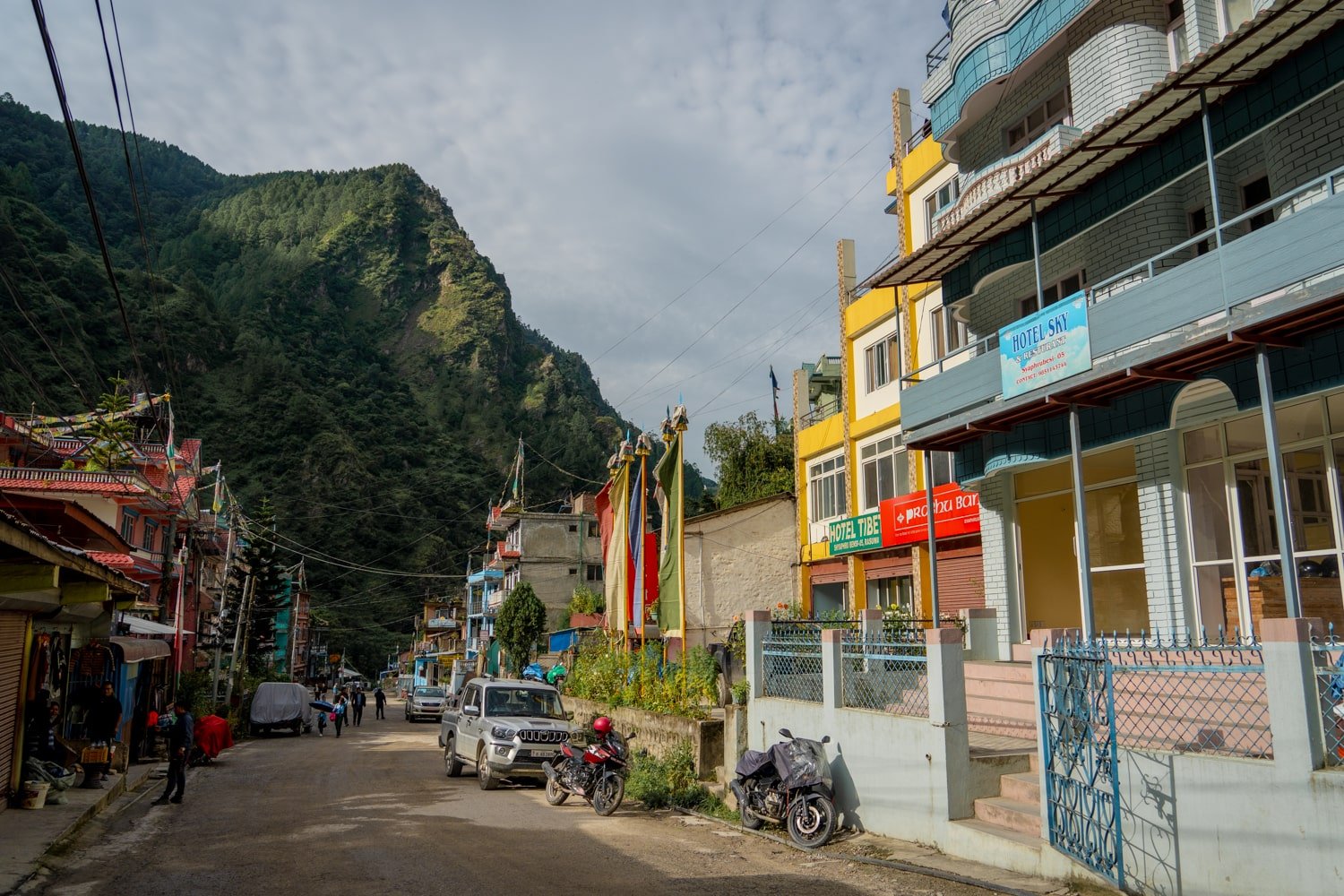
The “first day” of your Langtang trek itinerary won’t involve any trekking.
Instead, day one is all about getting to the village of Syabrubesi (also spelled Shyaphru Besi) where you will officially begin your trek the following day.
The village of Syabrubesi is only 110km from Kathmandu, but due to the mixture of muddy, mountainous roads and congested traffic, it takes the entire morning and afternoon just to get there.
That said, there are two ways to get from Kathmandu to Syabrubesi:
- Local bus (cheap but takes 7-9 hours or more depending on weather, traffic, etc.)
- Private jeep (expensive but more comfortable, expect around 5-6 hours travel time)
The bus to Syabrubesi from Kathmandu leaves from Machha Pokhari New Bus Park (location) around 7:30 am and costs approximately 1000 Nprs per person.
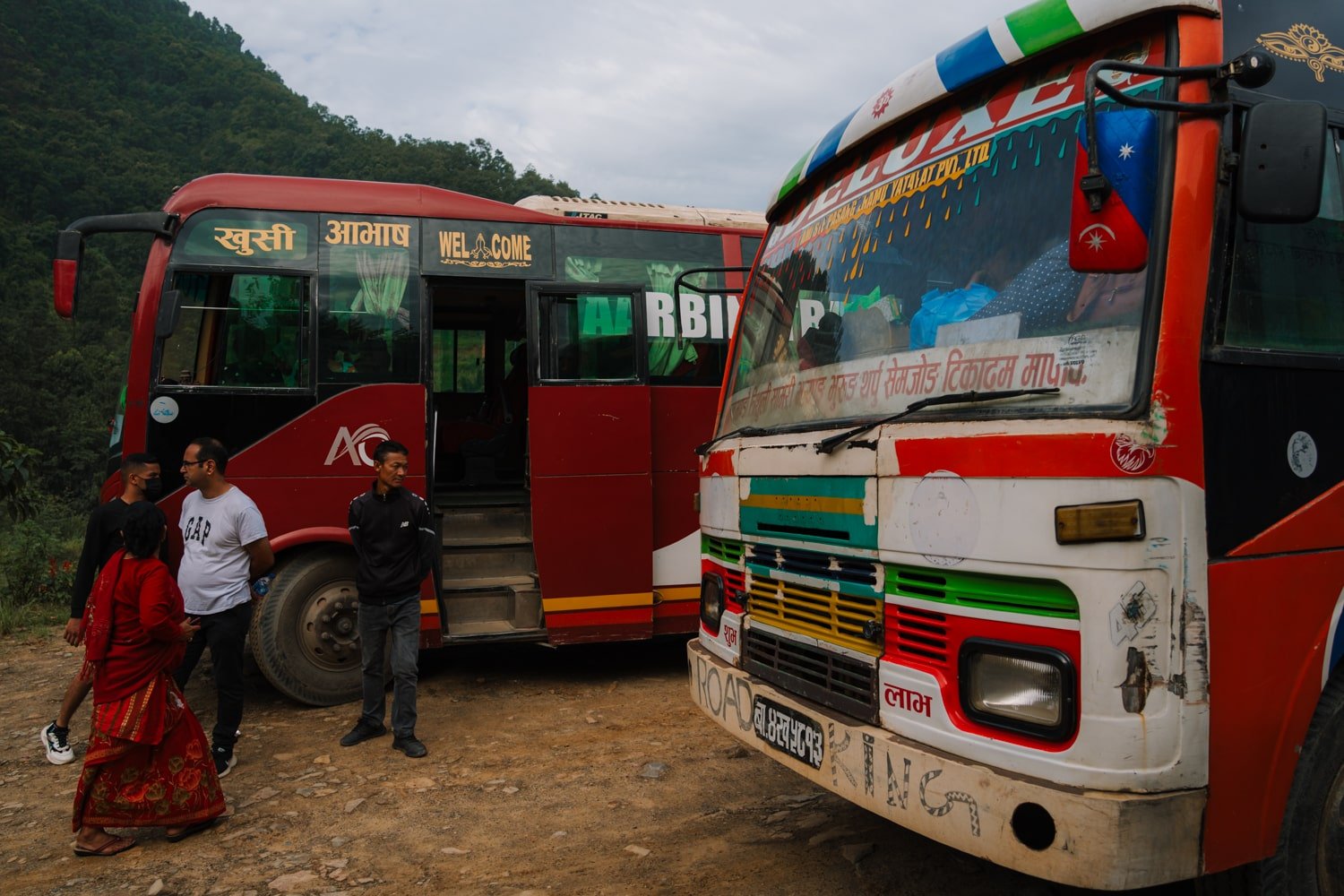
A bit of forewarning: the bus journey is long, loud, and fairly uncomfortable. 🙂
However, I’m glad to have had the experience (my group did opt for the private jeep back from Syabrubesi to Kathmandu post-trek, just FYI!).
If you do take the bus, whether independently or with your trekking company, make sure to pack a “bus bag.”
Carry your wallet, camera, water, passport, and anything else you may want for the bus ride (a pack of tissues or toilet paper, snacks, and chapstick, for example!).
Along the way, you will need to show your passport and pay the entry fee at the checkpoint for Langtang National Park, so keep those handy!
Once you reach Syabrubesi, you will check in to your hotel and have the remainder of the afternoon/evening (or what’s left of it!) free.
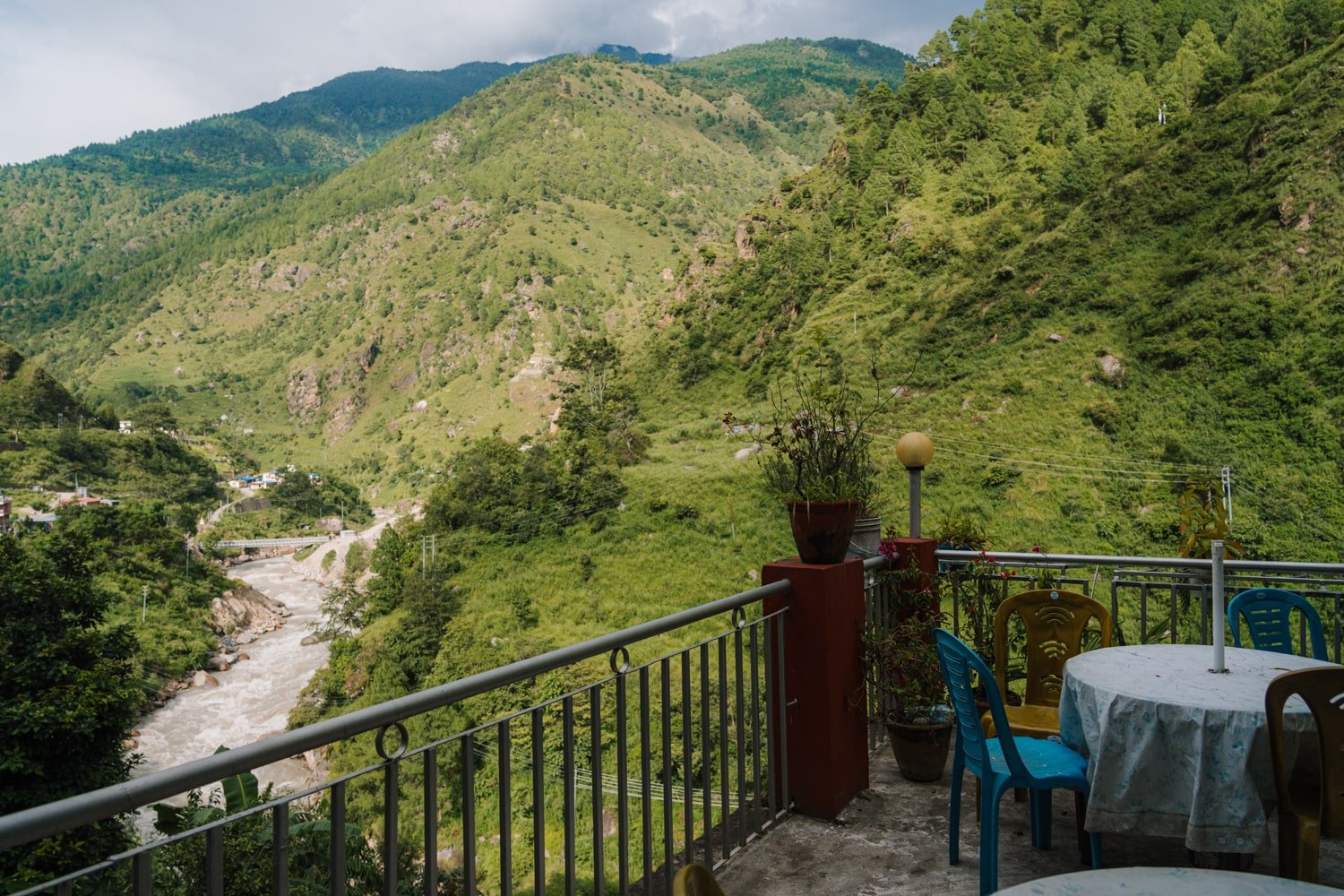
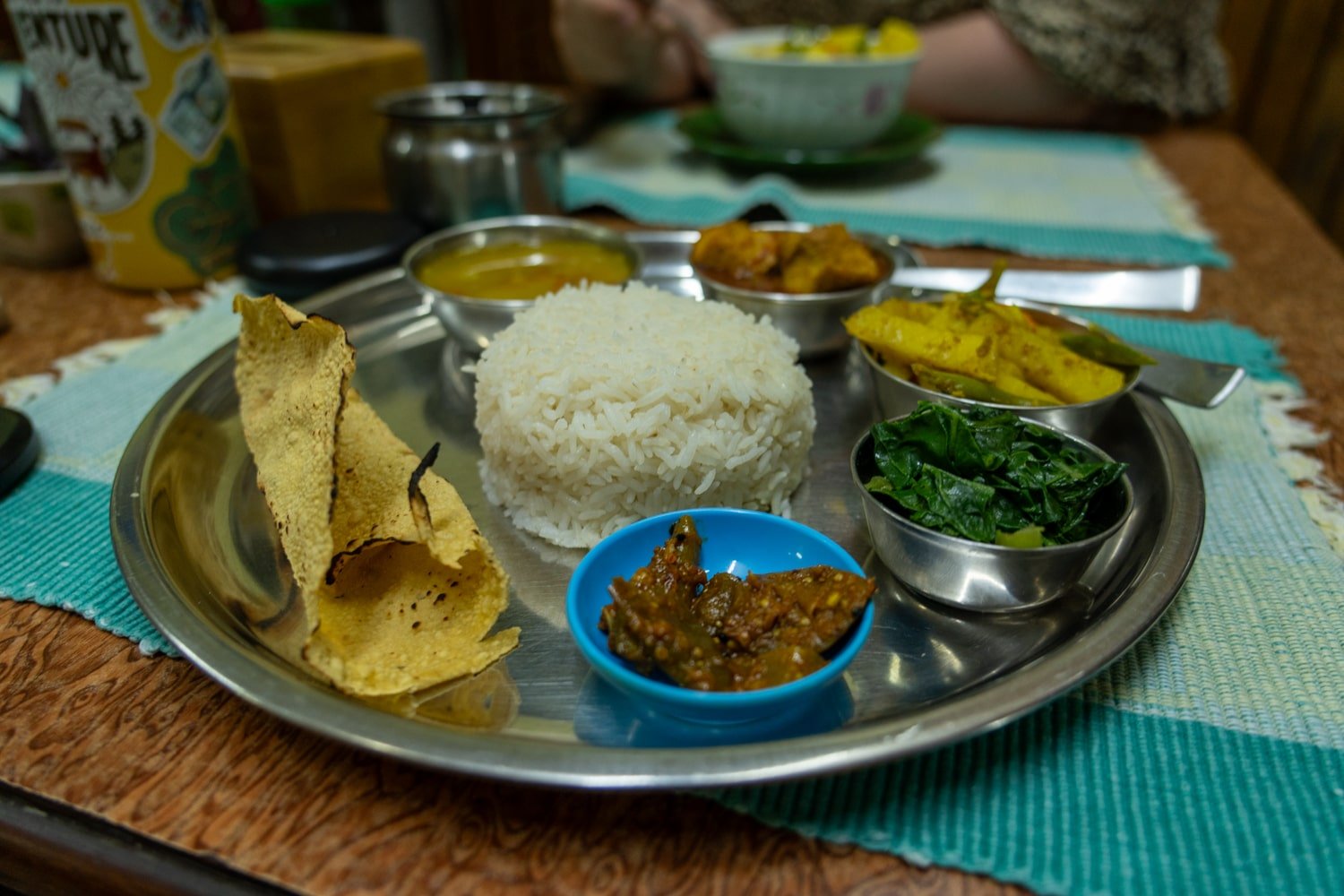
We stayed at the Old Namaste Guesthouse which had really friendly hosts/owners, warm showers (towel upon request), Wi-Fi, comfy beds, and delicious home cooking.
You should consider booking your Langtang teahouses/accommodation in advance for the high season (October onward), particularly if you plan to trek Langtang Valley without a guide. If you go with a guide, you won’t have to worry about all the logistics as accommodation, food, and transport will be taken care of for you.
Day 2: Syabrubesi to Lama Hotel (Changdam Village)
- Route: Syabrubesi (1460m) to Lama Hotel (2470m)
- Trekking time: 7-8 hours
- Distance: 11.3km / 7 miles
- Highlights: Bamboo forest, swinging bridges, river crossings, waterfalls
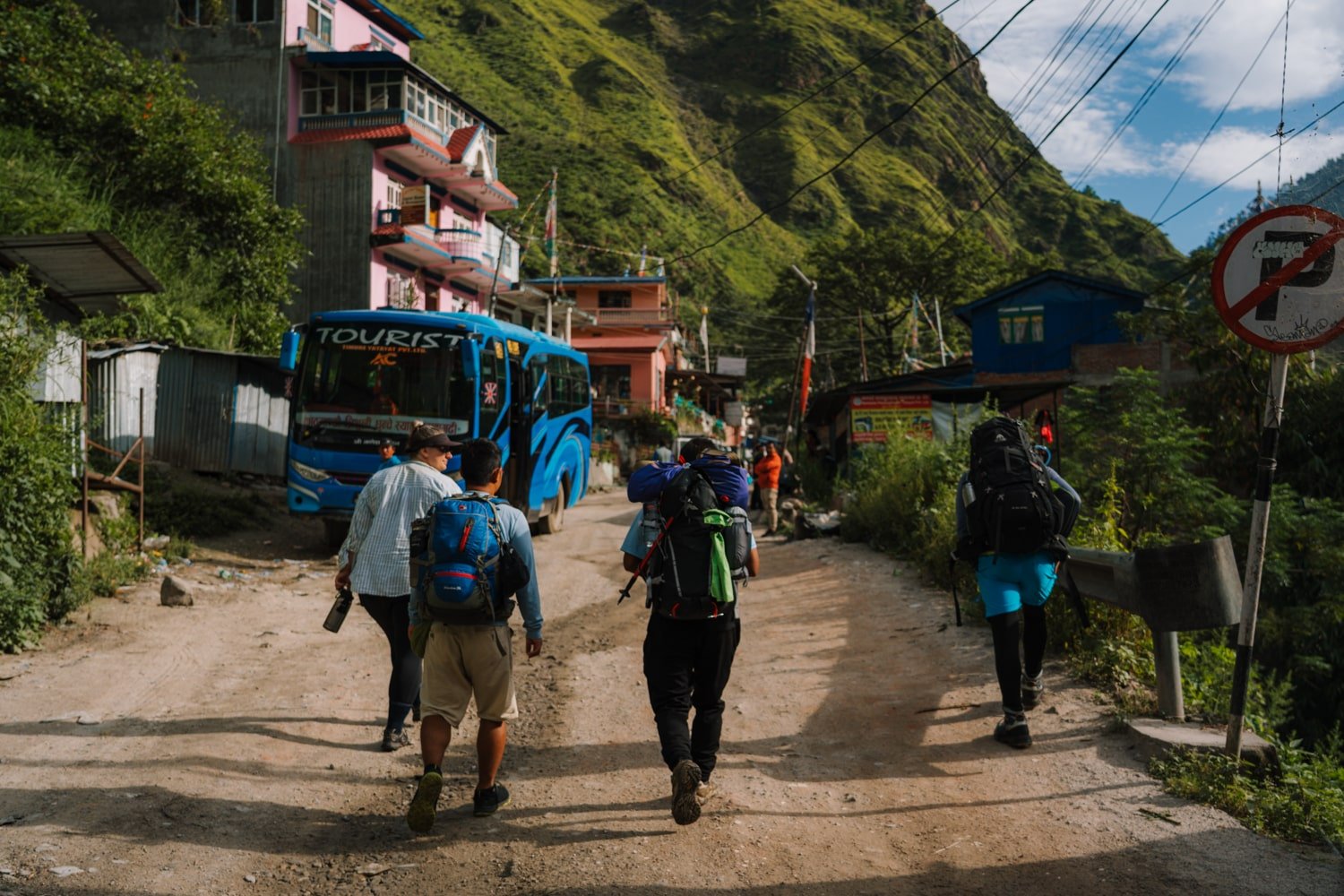
This is the first actual day of the Langtang trek, and it’s a long one!
Expect a variety of terrain and landscapes from Syabrubesi to Lama Hotel, such as cascading waterfalls, humid bamboo forests, and muddy riverside trails.
The elevation gain from Syabrubesi to Lama Hotel in Changdam village is about 1000m.
There are some steep stair sections along this route as well as gravely slopes from past landslides that you may have to scramble across.
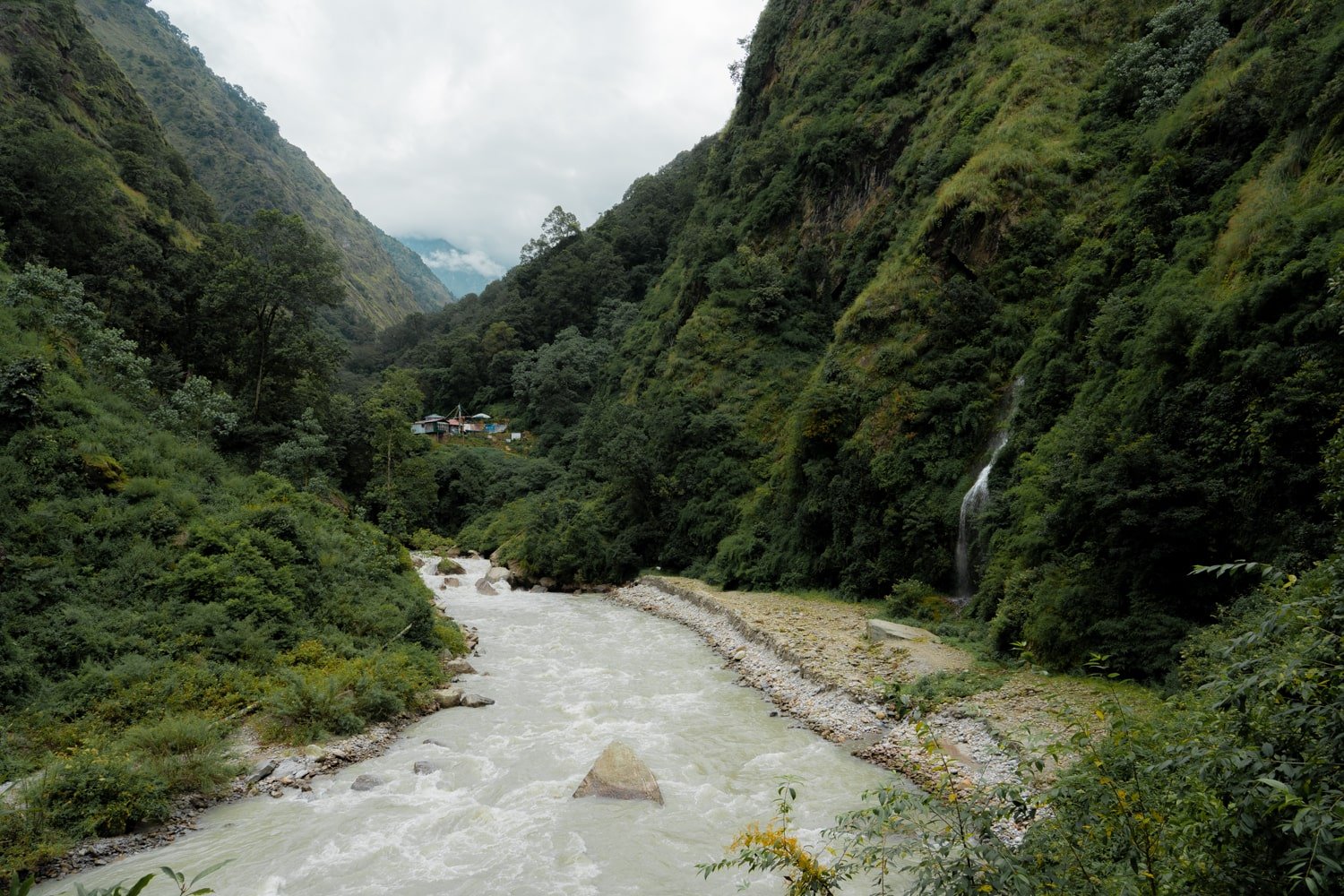
I’ll not forget this section of the Langtang trekking route, as I associate it with “leech day.” 😬 The humid forest and recent rains brought out the leeches and one sucked on my stomach!!
So, be clothes-wise and wear long trousers versus shorts, and pay attention to any odd “sore spots” on your skin.
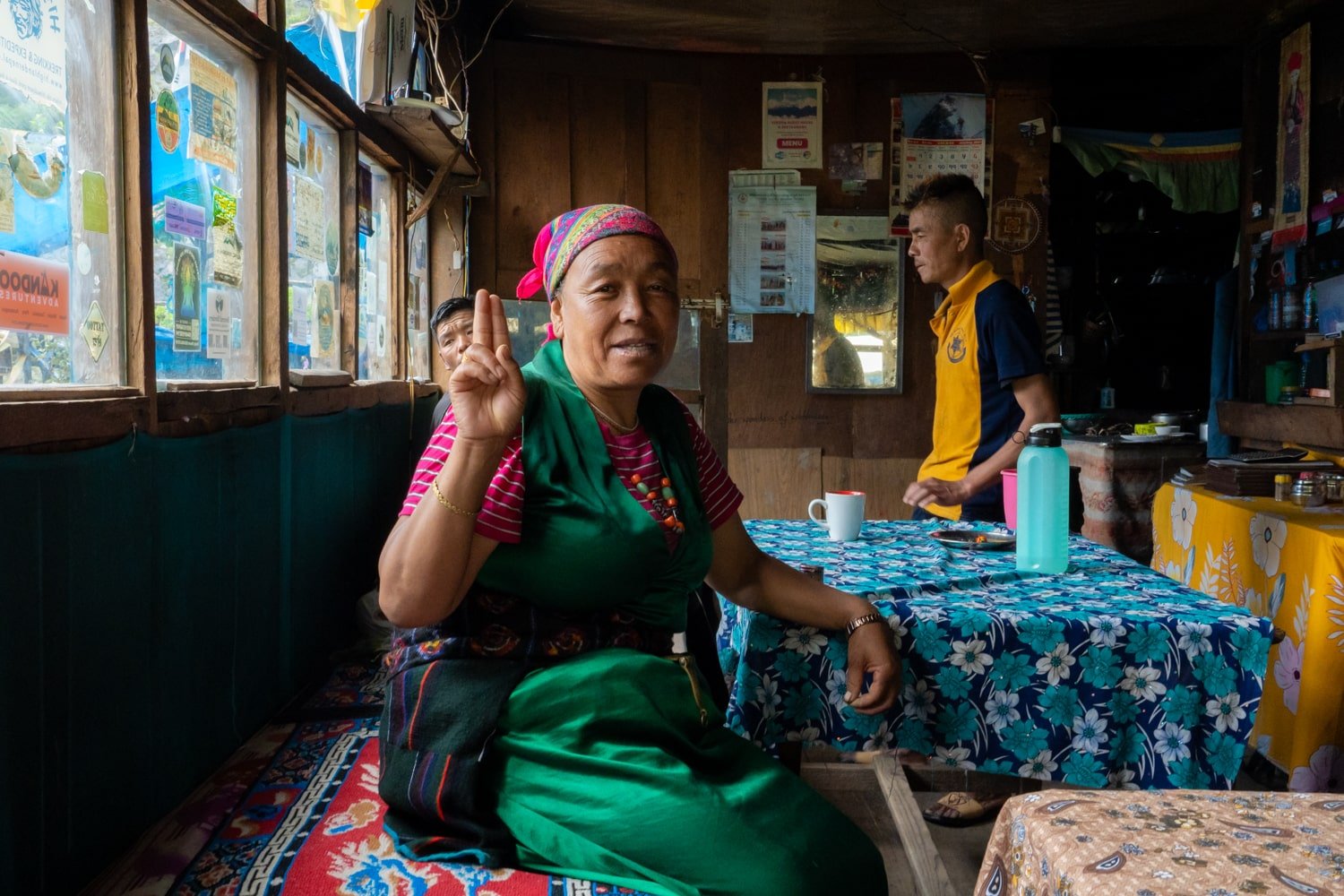
For lunch, there are several teahouses along the route.
The Bamboo Lodge or Dholmen River Guesthouse will be among the first you’ll reach before continuing on to the Lama Hotel and getting there by mid to late afternoon.
As for where to stay once you reach Changdam/Lama Hotel, the Origin Lama Hotel is a great choice and it’s located at the back of Changdam village.
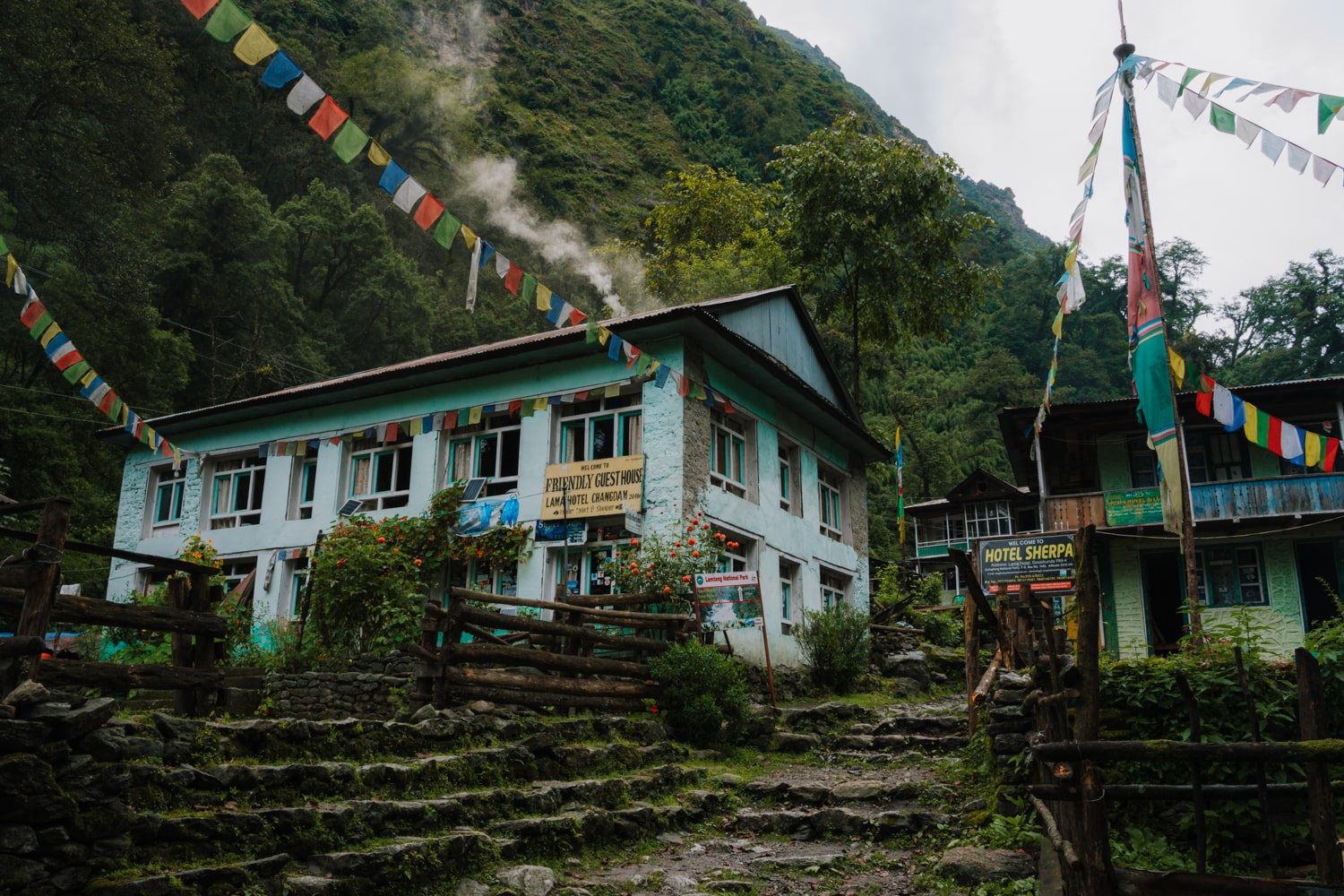
Keep in mind that there are no data/Wi-Fi or power outlets at the Origin Lama teahouse, so bring a battery pack charger and a book or Kindle.
The shower/bathroom facilities and lodging at Lama Hotel are simple but comfortable. By the way, Kampua (the host) makes a delicious aloo chapati or potato pancake!
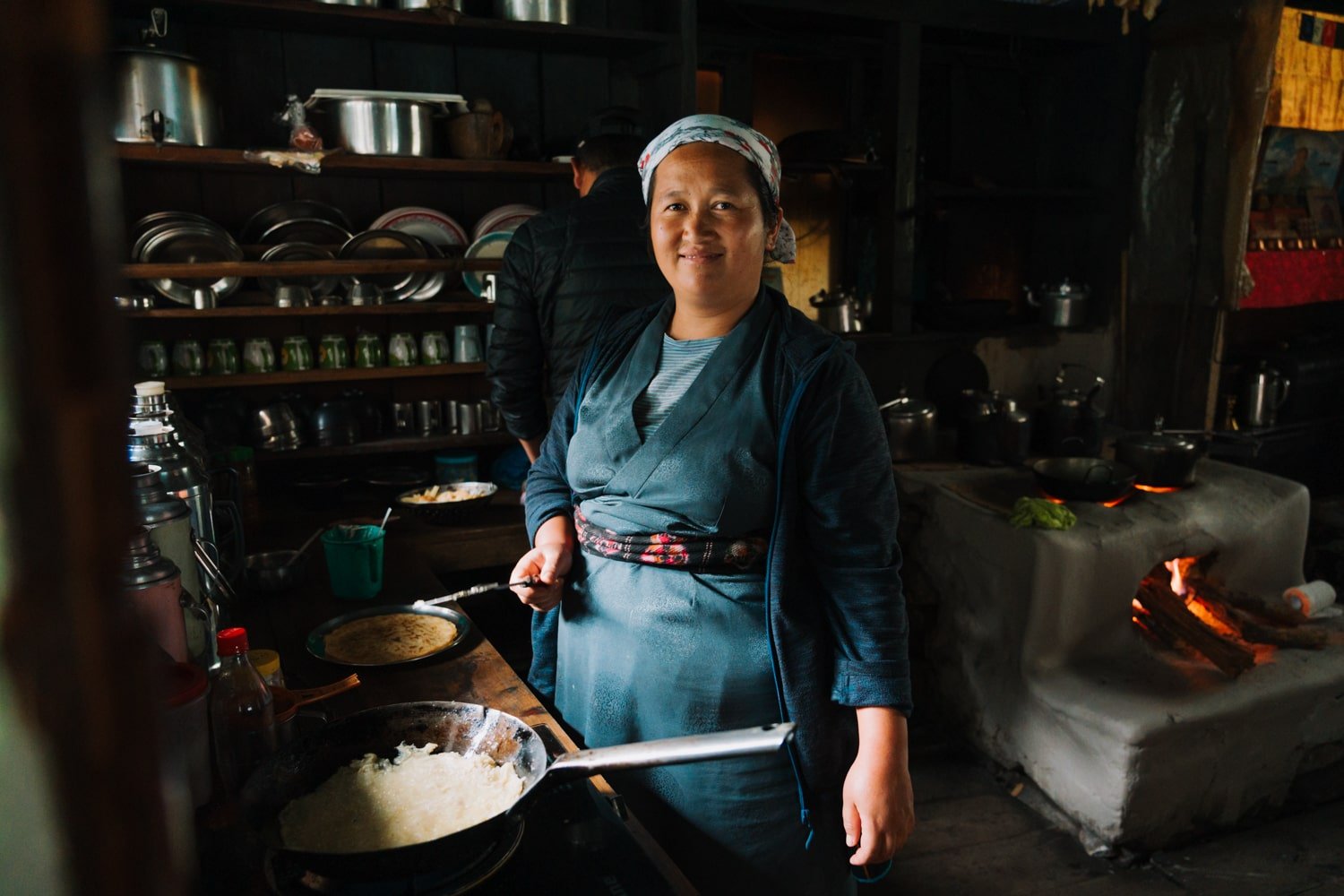
If the Lama Hotel is full, the Friendly Guesthouse (at the front of the village) also comes highly recommended.
Day 3: Lama Hotel to Langtang Village
- Route: Lama Hotel (2470m) to Langtang (3430m)
- Trekking time: 7-8 hours
- Distance: 14.7km / 8 miles
- Highlights: Wildflowers, meadows, waterfalls, valley and mountain views, teahouses
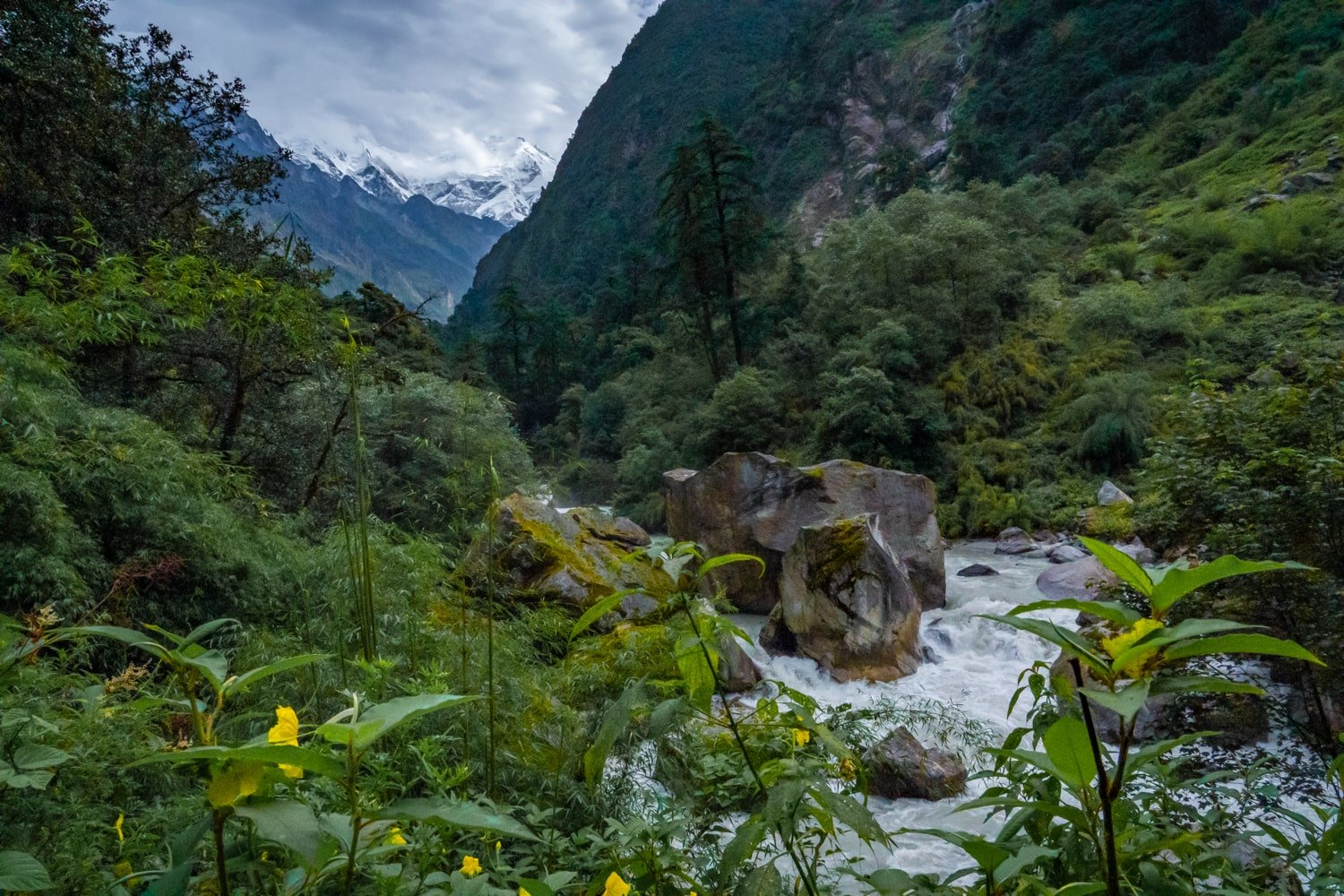
Prepare mentally for the second full day of the Langtang trek as it’s another long one to reach the village of Langtang!
With clear weather and a bit of luck, you might get to have a first glimpse at the snow-capped Langtang peaks in the distance after you pass through rhododendron forests.
About two hours in, you’ll reach the Riverside Hotel at Gumnachok.
The following hour is tough as you make your way up a steep section before the terrain and views open up in the valley, showcasing beautiful cliffside waterfalls and meadows of wildflowers.
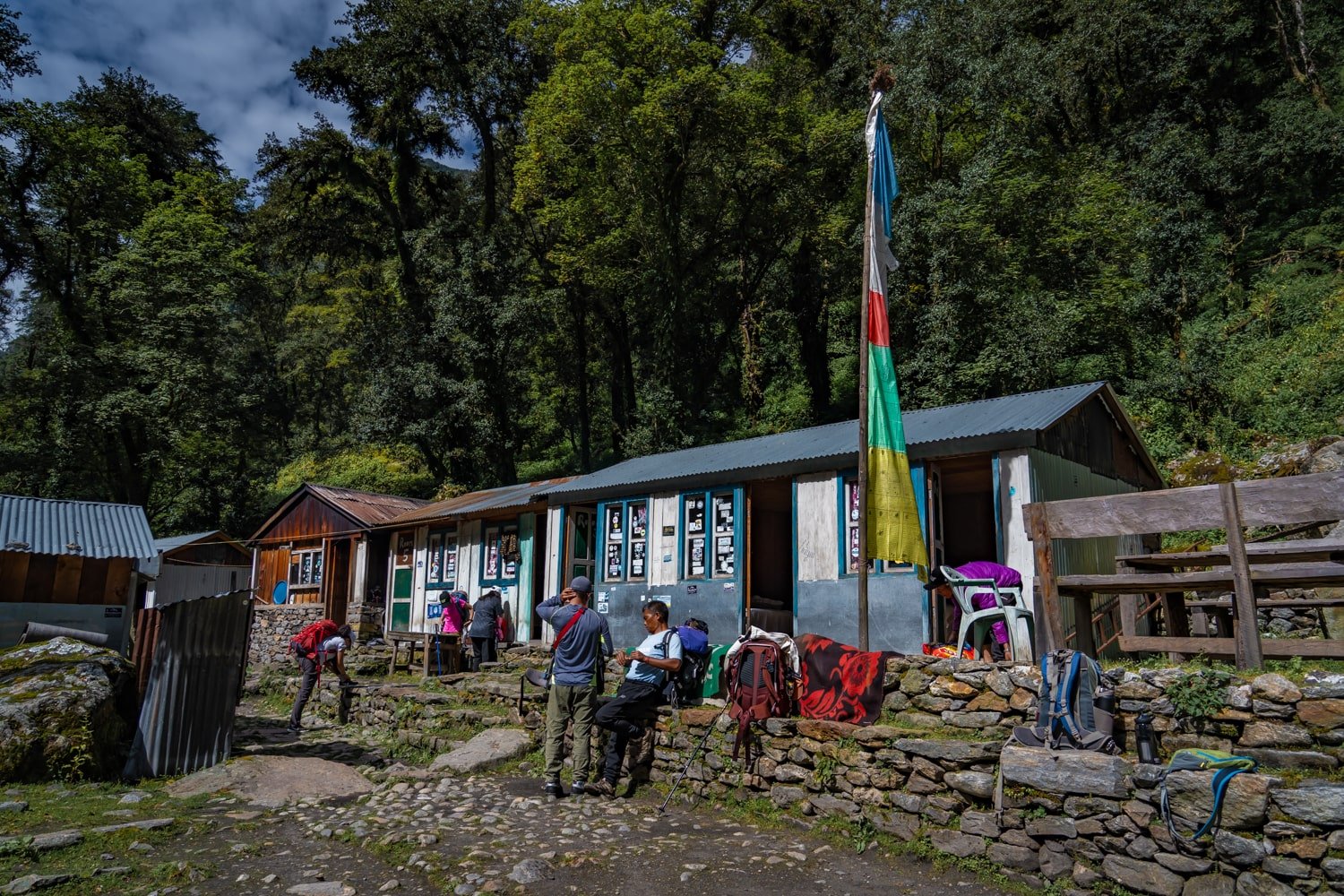
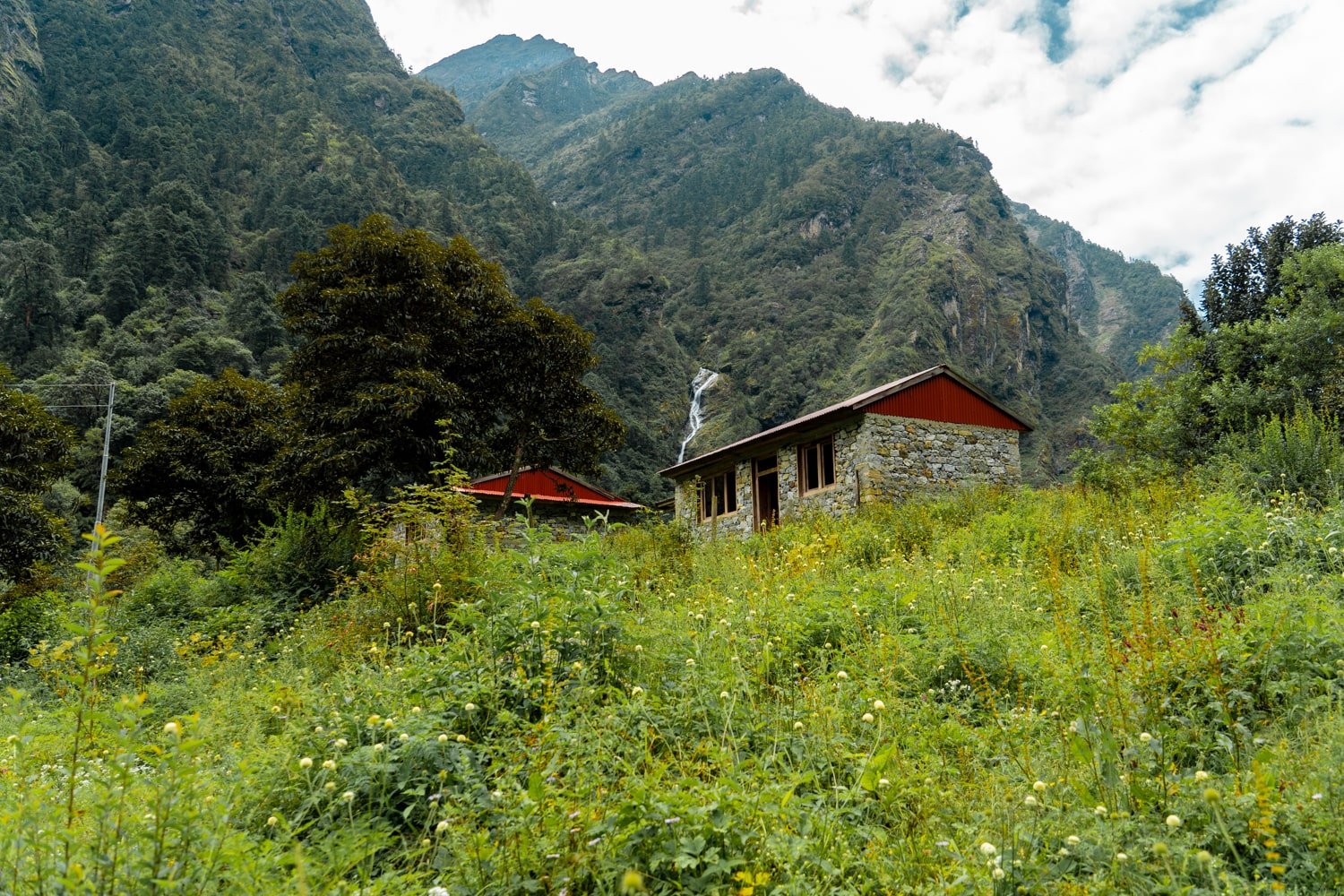
You’ll cross back over the river and continue to Godatabela, where you’ll stop for lunch at the scenic Hotel Tibetan.
From here, it takes about another hour to reach the Thangshap village (3200m).
The last section of today’s trek takes you on the left side of the river all the way to Langtang.
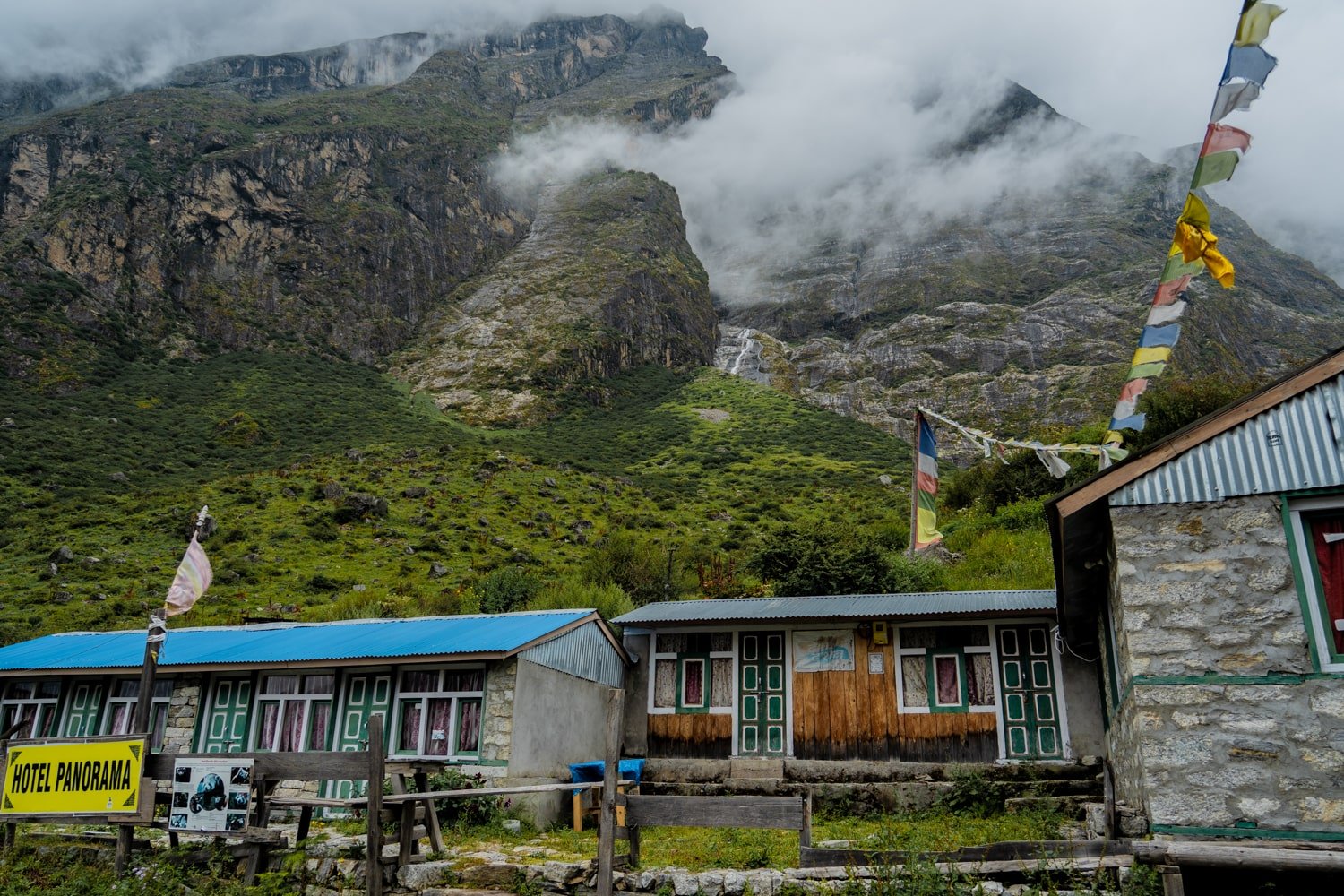
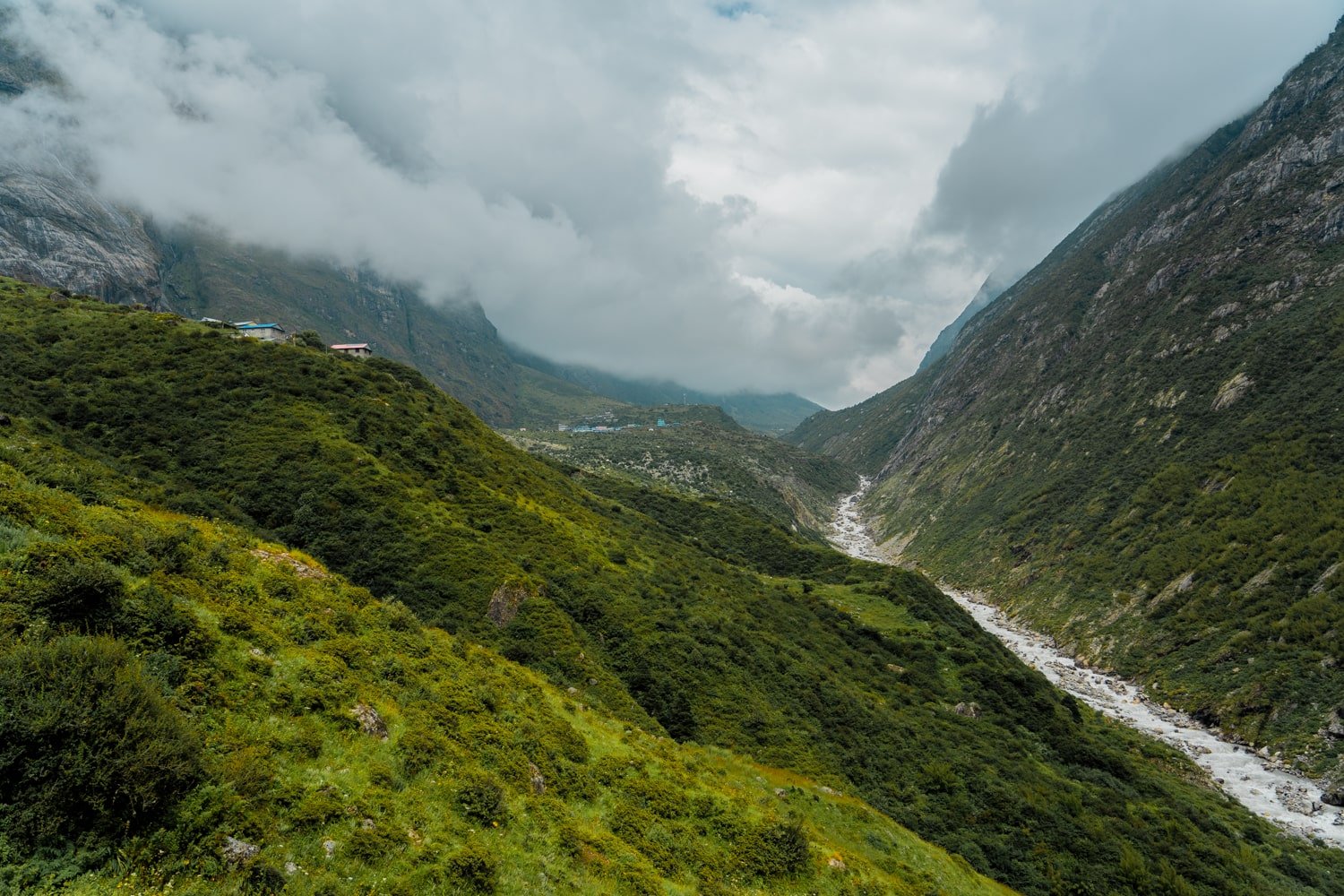
You’re officially trekking through the “Valley of the Glaciers” which Langtang is known for!
Before reaching the new Langtang settlement, you will witness and cross over the aftermath of the 2015 earthquakes which caused a fatal landslide that wiped out the former Langtang village.
There is only one traditional-style house left standing, which belongs to my friend’s father, Mr. Lama (whose teahouse—Yeti Guesthouse—you can stay at in Kyanjin Gompa).
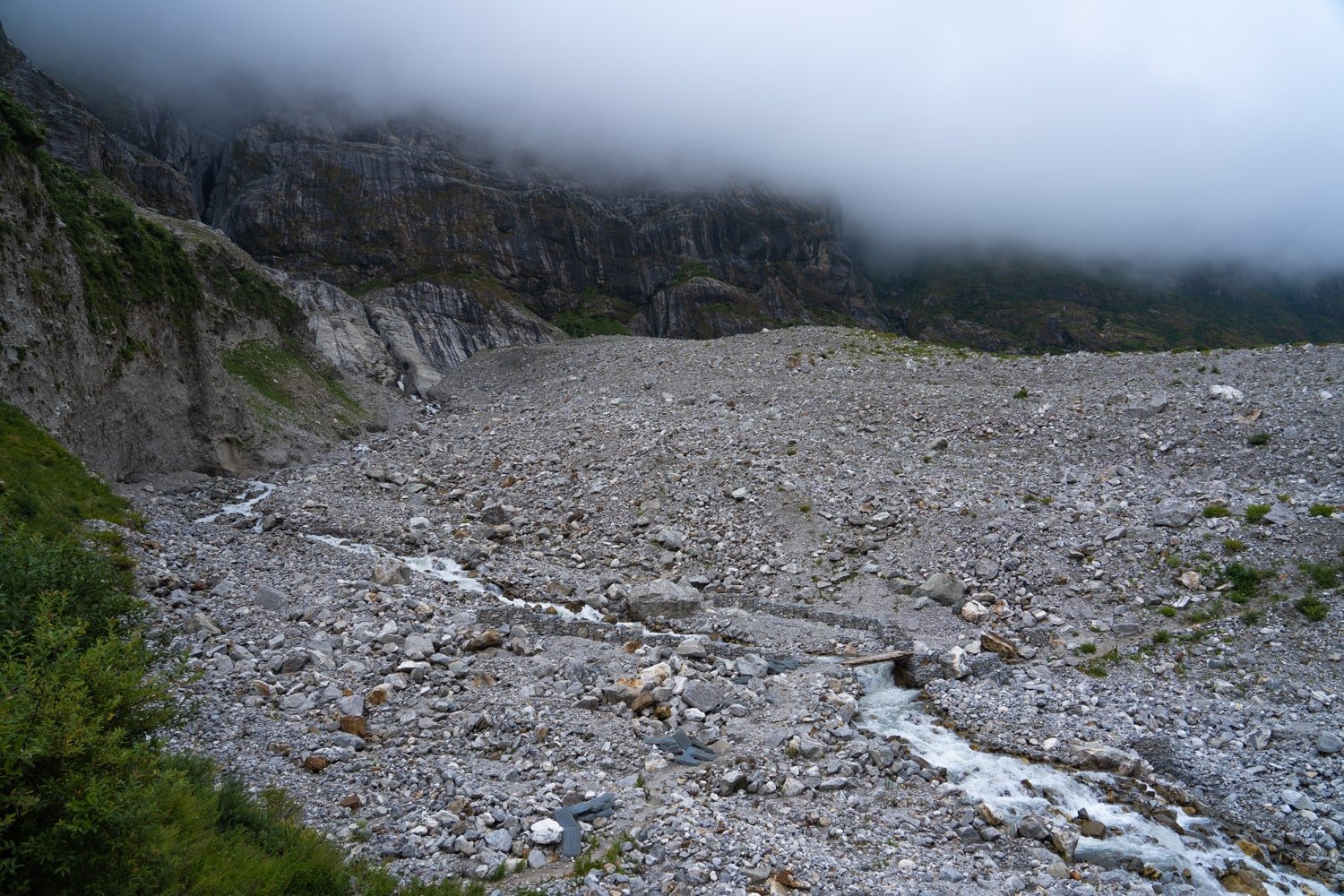
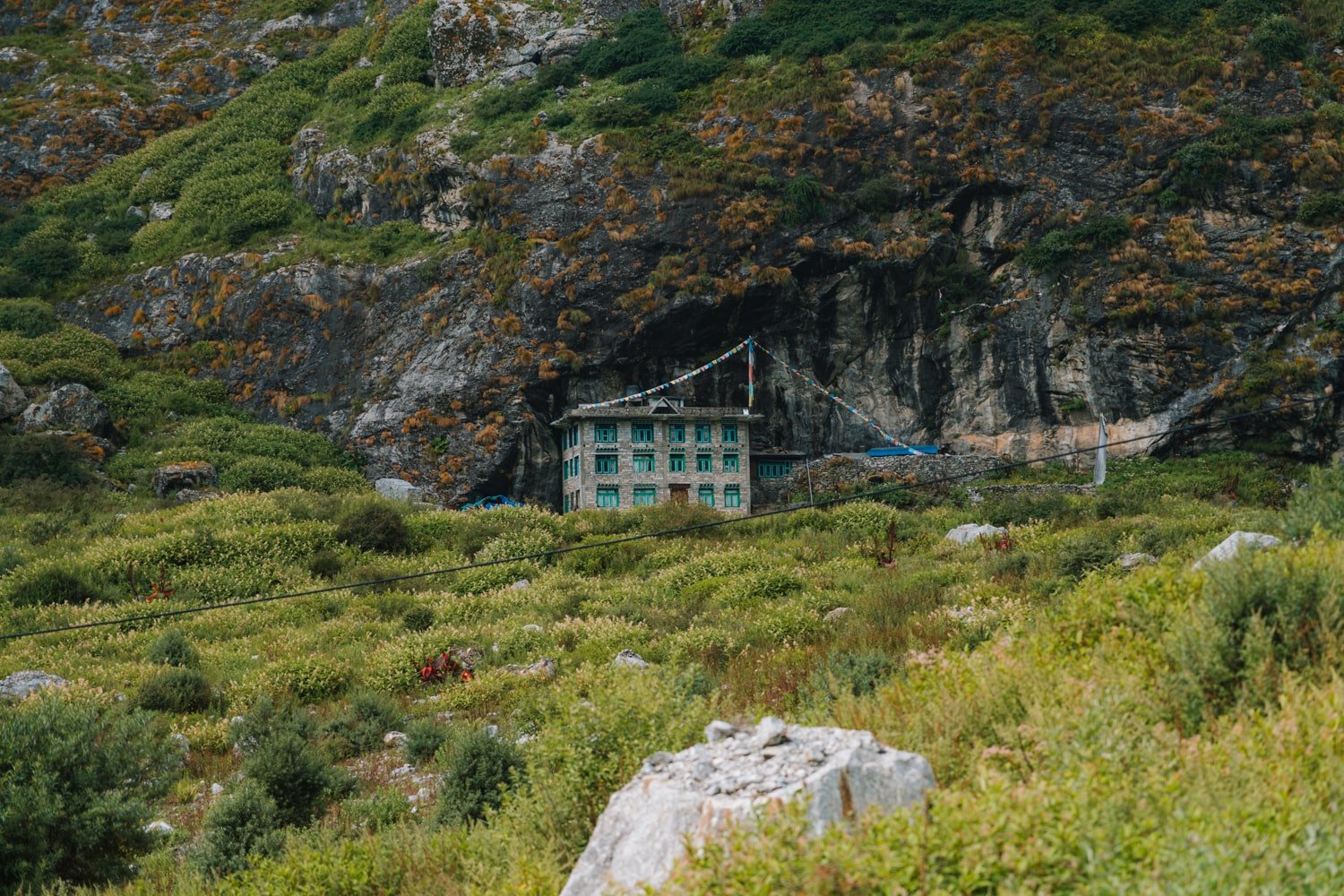
Day 4: Langtang to Kyanjin Gompa + Kyanjin Ri
- Route: Langtang village (3430m) to Kyanjin Gompa (3870m) to Kyanjin Ri (4773)
- Trekking time: 6 hours, and then to reach Kyanjin Ri from Kyanjin Gompa 2 hours up, 1-1.5 hours down
- Distance: 5.7km / 3.5 miles, and then around 4km / 2.5 miles from the Kyanjin Gompa village to Kyanjin Ri
- Highlights: Villages, Buddhist mani walls, valley and mountain views, river crossings

You will reach your final destination on the third day of the Langtang trek—Kyanjin Gompa!
As the last village along the Langtang Valley Trek, this is where you will stay for the following two nights before retracing your steps back to Syabrubesi.
While this day is shorter and easier than the first two days, the afternoon day trip up to Kyanjin Ri from Kyanjin Gompa adds another challenge.
Personally, this was my favorite day of the trek! The views of the valley, waterfalls, villages, and wildflowers (in September) along the way are just gorgeous.
A unique highlight during this day of the Langtang Valley trek is the Buddhist mani walls with Tibetan script engravings.
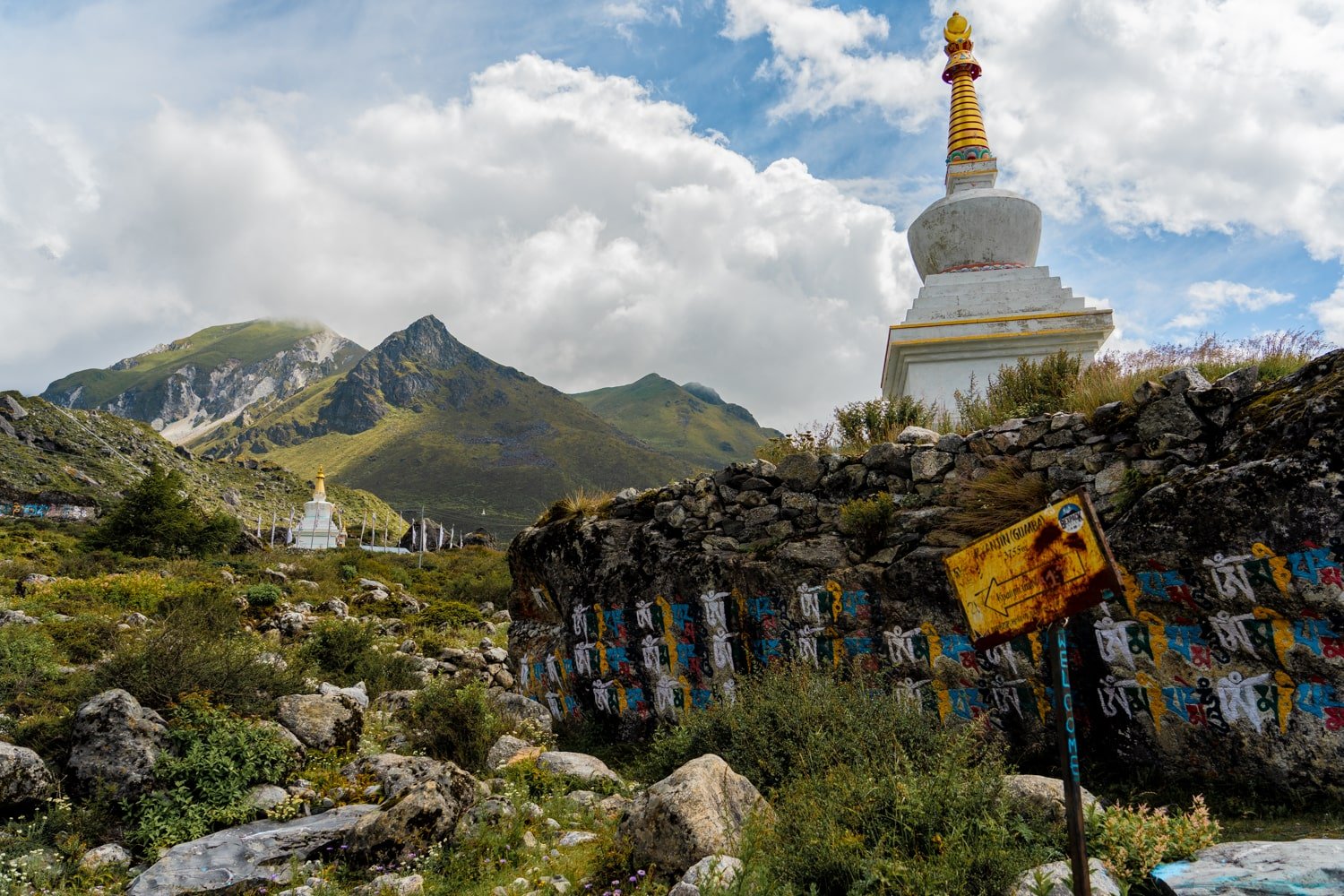
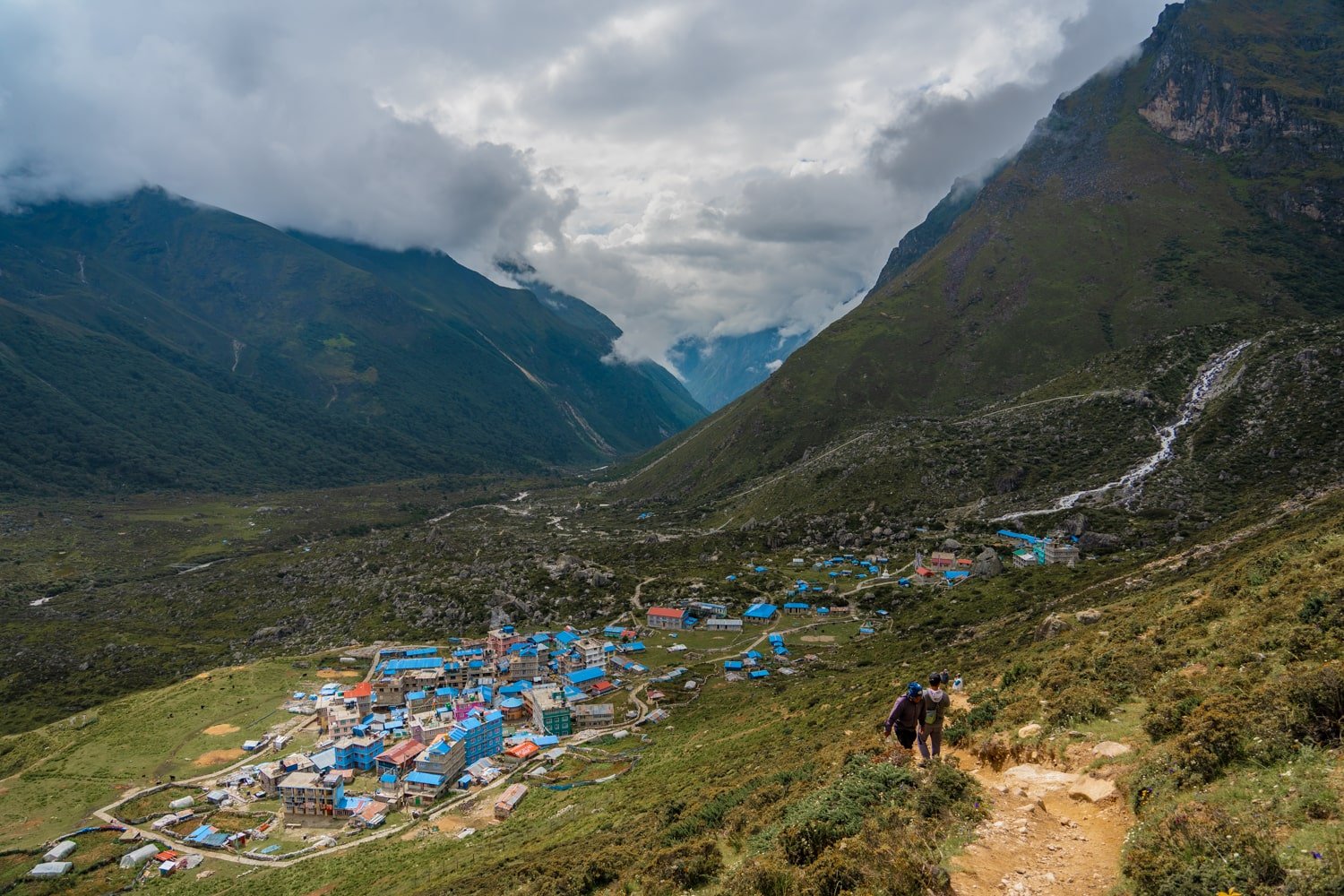
Your group may decide to hike up to Kyanjin Ri the following day (instead of opting for Tserko Ri), however, my group decided to do Kyanjin Ri in the afternoon and then Tserko Ri the following day.
Either way, getting to Kyanjin Ri from Kyanjin Gompa is not to be underestimated; you will climb nearly 1000m in elevation in a short amount of time.
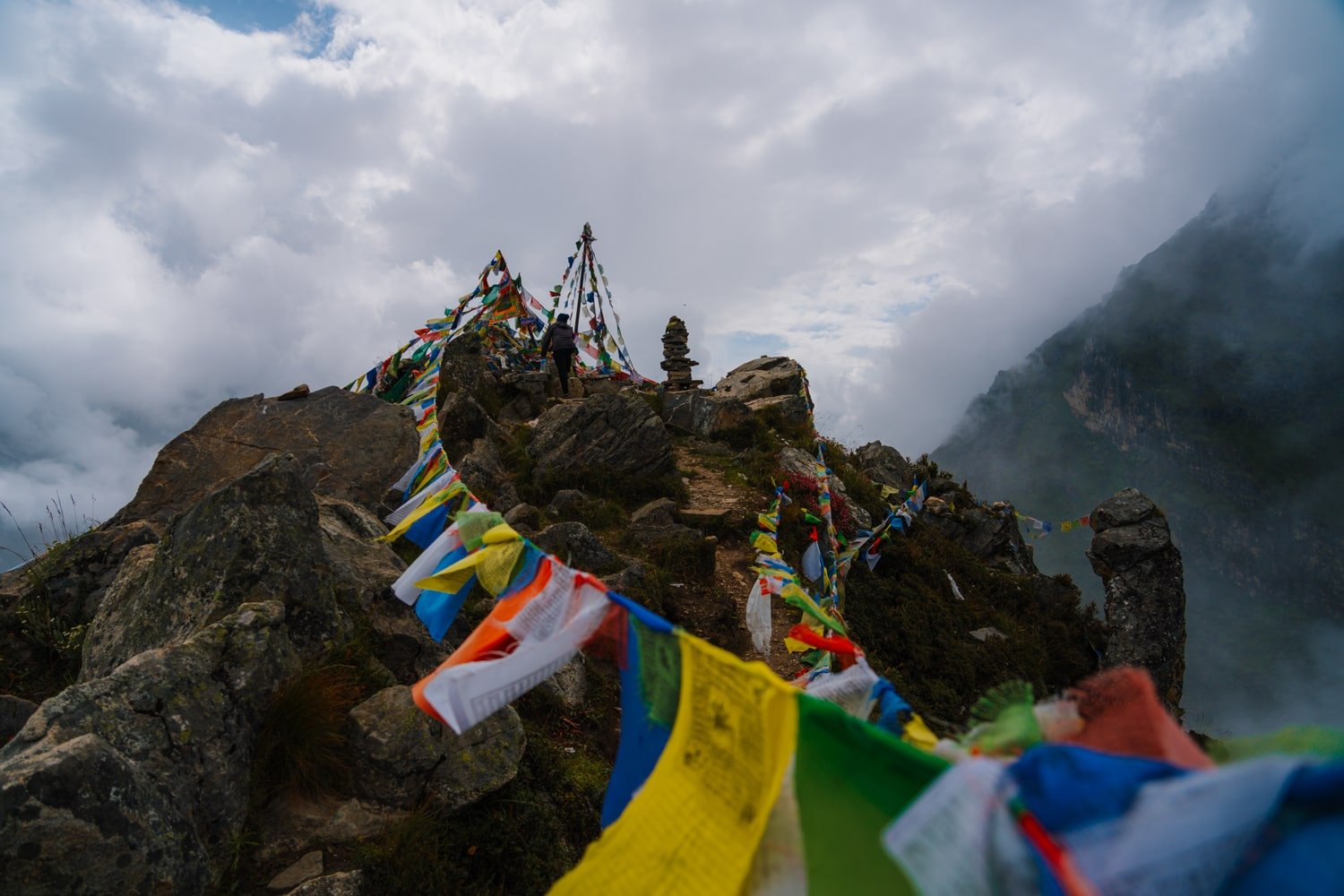
That said, I’d recommend taking two trekking poles and wearing a knee brace as coming down does wear down the knees. There are many sections where you might have to use your hands to scramble.
The day trip up to Kyanjin Ri is definitely challenging, but just know that the views absolutely make it worth it!
Day 5: Kyanjin Gompa to Tserko Ri (Day Trip)
- Route: Kyanjin Gompa village (3970m) to Tserko Ri summit (4984m) out-and-back
- Trekking time: At our pace about 4 hours up, 3 hours down
- Distance: 9km / 5.5 miles
- Highlights: Glaciers, snow-capped peaks, yak pastures, Tserko Ri
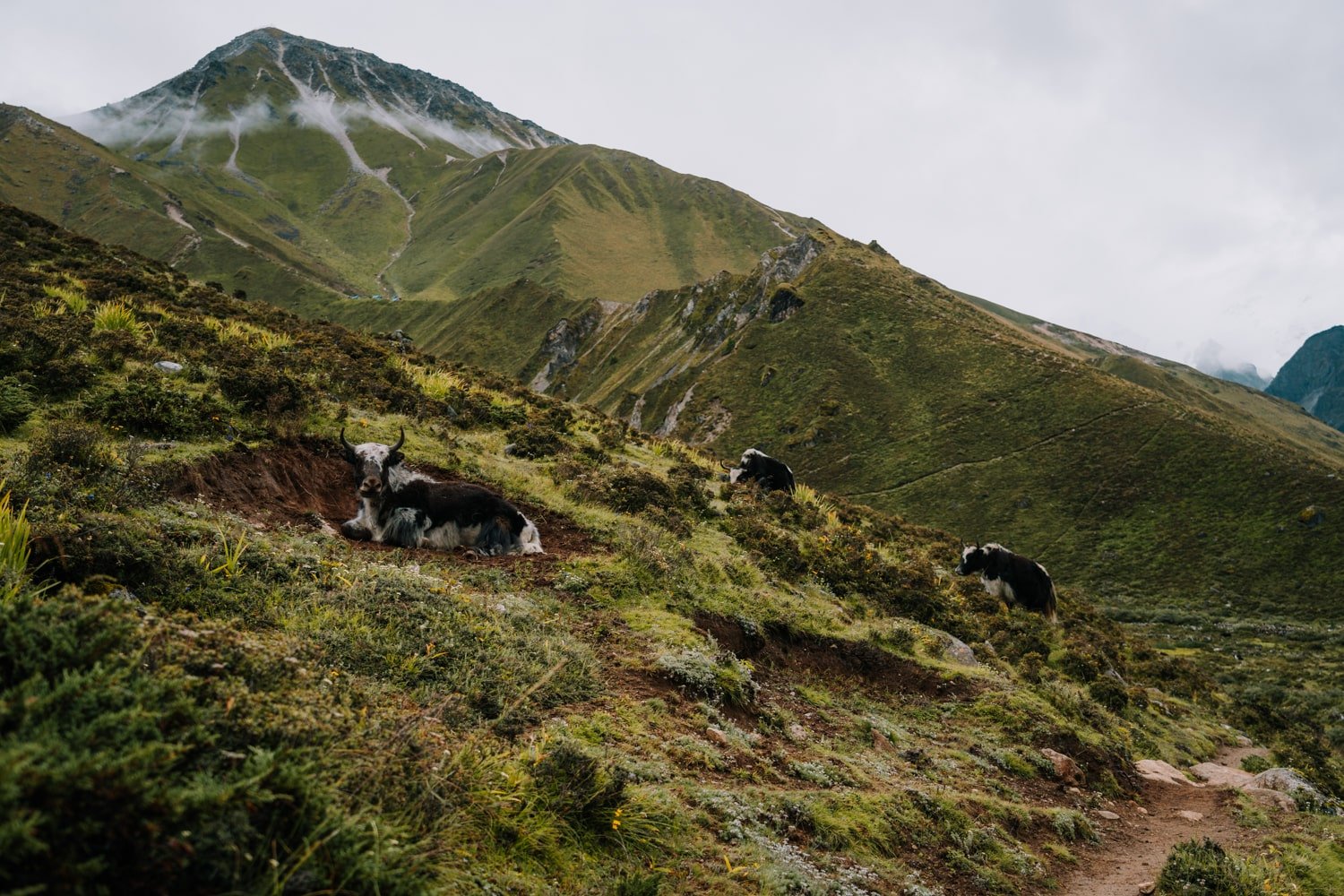
Today, you can leave your big backpack at your guesthouse in Kyanjin Gompa because today is just an out-and-back day trip from Kyanjin Gompa to Tserko Ri (still take a small bag for water and essentials).
It is best to leave early, as the weather atop Tserko Ri (4984m) tends to get cloudy later in the day.
From this exceptional viewpoint, you have the chance to see around twenty peaks including the highest of all in the Langtang Himalayas, Langtang Lirung (7234m / 23,733ft).
The route is easy to follow, exiting north of the village and continuing beyond the fields where the yaks graze. Once you cross the river, there is a steep zig-zag section that, once at the top, levels out slightly.
From here, you can see the tents where local shepherds tend to the yaks and make yak milk and cheese and several peaks and glaciers in the distance.
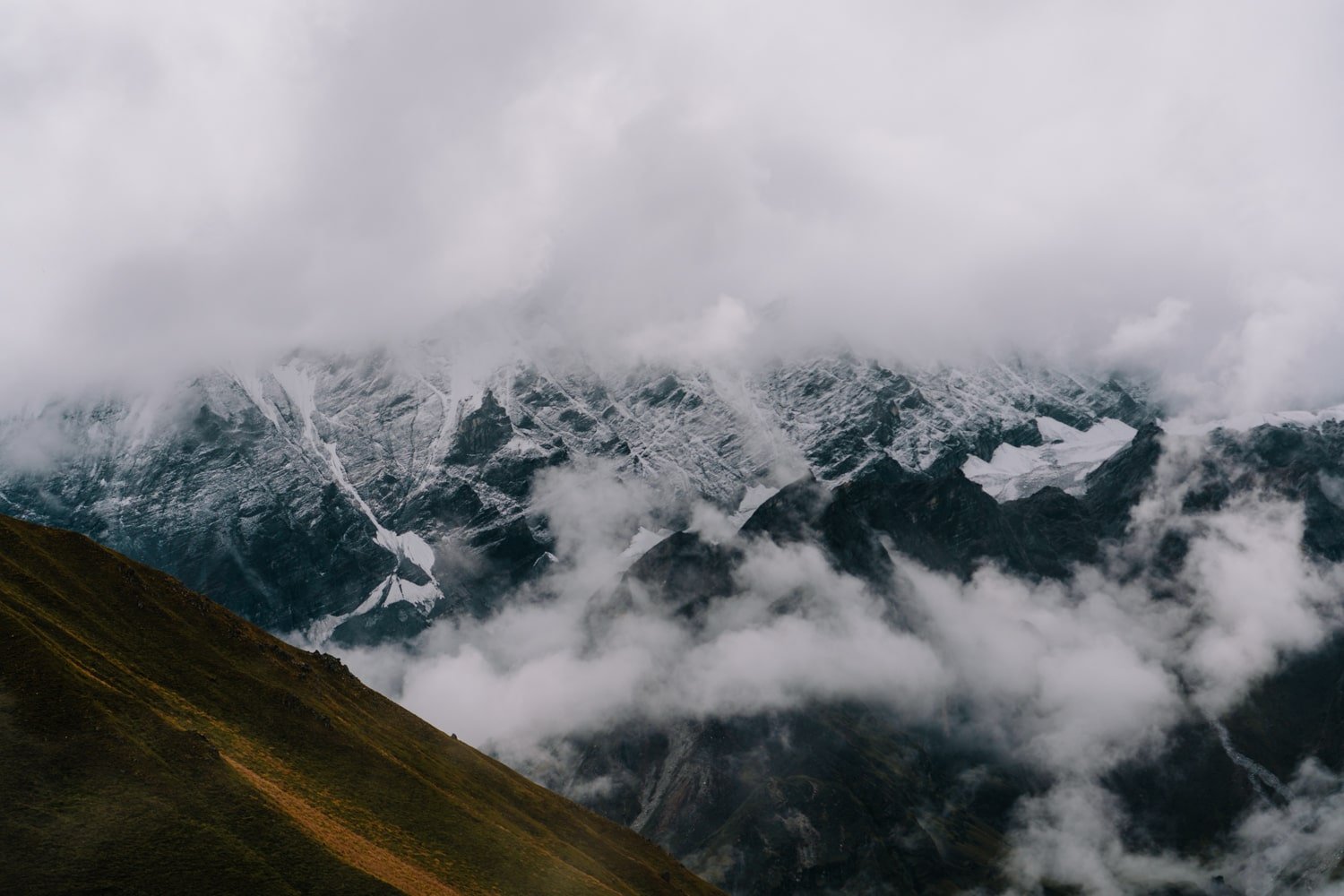
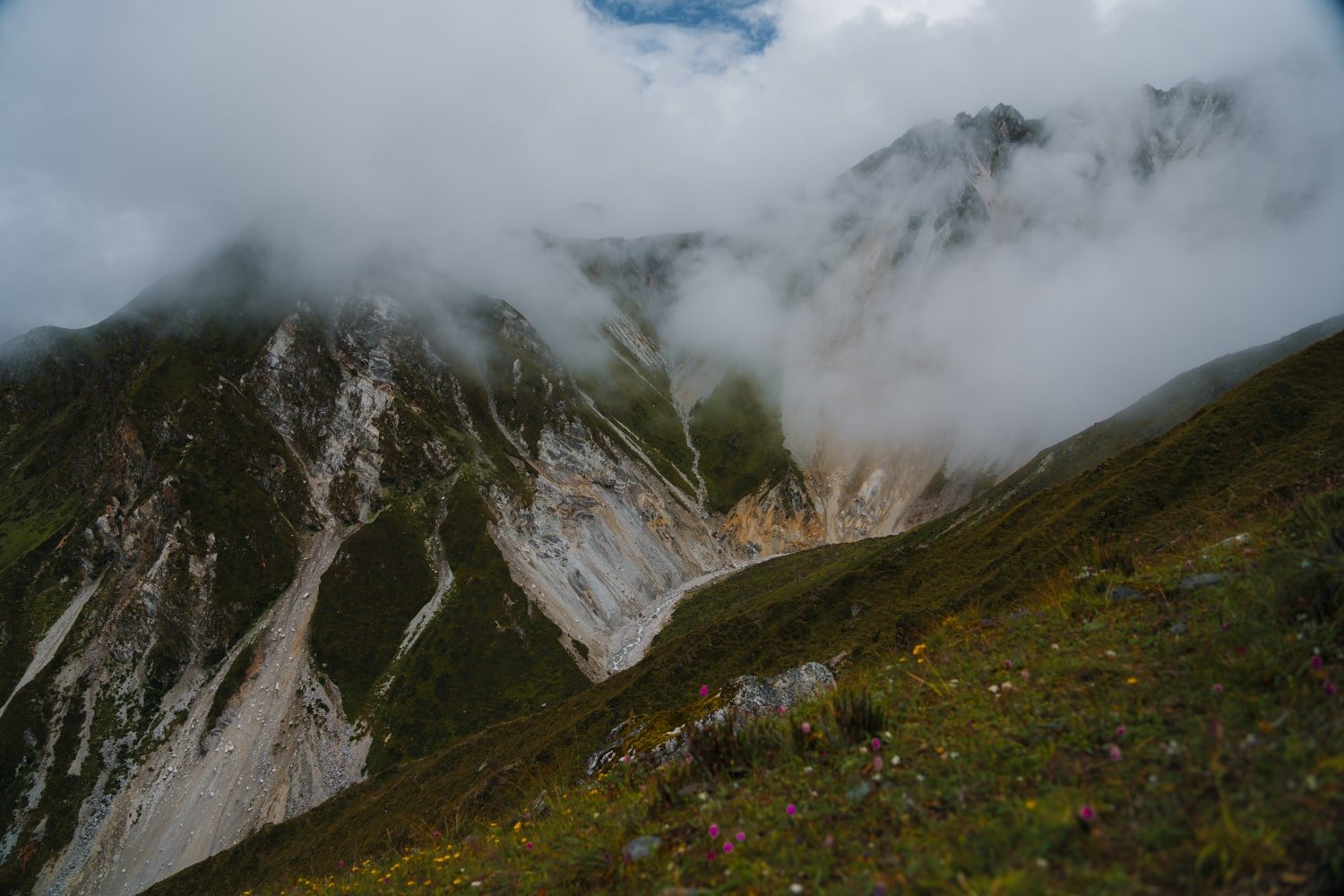
The trail continues up and up over a grassy plain and past an abandoned horse and yak encampment until you eventually reach the large rocky section which feels more like a giant staircase until the end.
From that point, there is still another solid 1+ hour before you reach the very top where you can have lunch and soak in the 360-degree mountain and glacier views (on a clear day!).
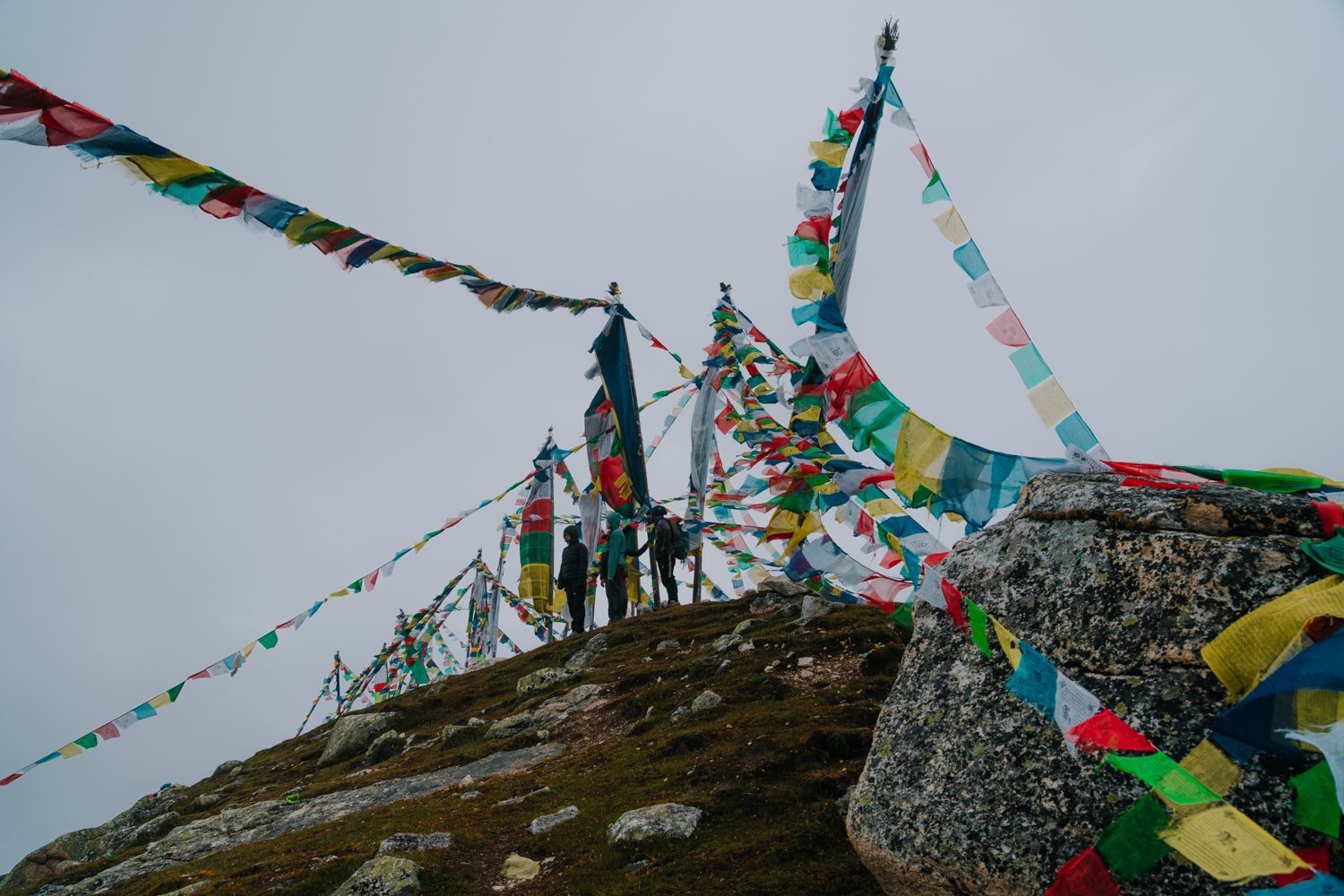
If you’re like me and get weak knees with continuous downhill hiking, then this might be the hardest day for you. Having already spent my knees on the trip up to Kyanjin Gompa the day prior, this was indeed a real challenge for me.
Day 6: Kyanjin Gompa to Lama Hotel (Changdam)
- Route: Kyanjin Gompa (3870m) back to Lama Hotel (2470m) in one day
- Trekking time: 7-8 hours
- Distance: 14.5km / 9 miles
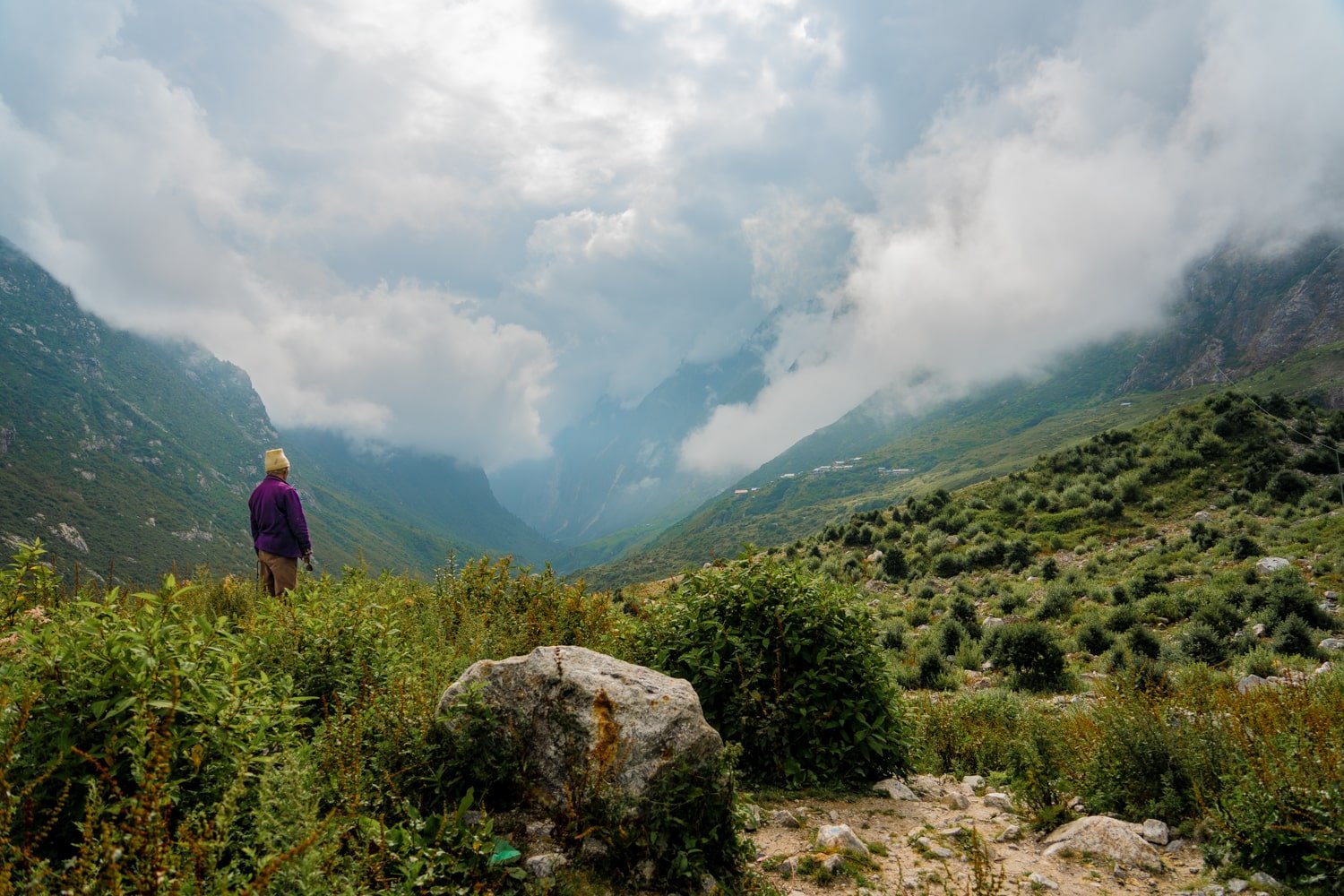
Day six is going to be the longest day of the Langtang trek in terms of total km/miles hiked, as you’ll retrace your steps from Kyanjin Gompa all the way back to Lama Hotel in one day!
While definitely doable for most, the fact that you’ll be going downhill (with a few uphill sections) and hiking a long time, can make it quite challenging (especially for those with sensitive knees, like me!).
That’s why I highly advise carrying and wearing supportive knee braces if you need them and using trekking poles.
I picked up my poles for 800 Rs at Makalu E-Traders in Thamel (they were the fairest with the prices that I found).
Day 7: Lama Hotel to Syabrubesi (Last Day Trekking)
- Route: Lama Hotel (2470m) back to Syabrubesi (1460m)
- Trekking time: 6-7 hours
- Distance: 11.3km / 7 miles
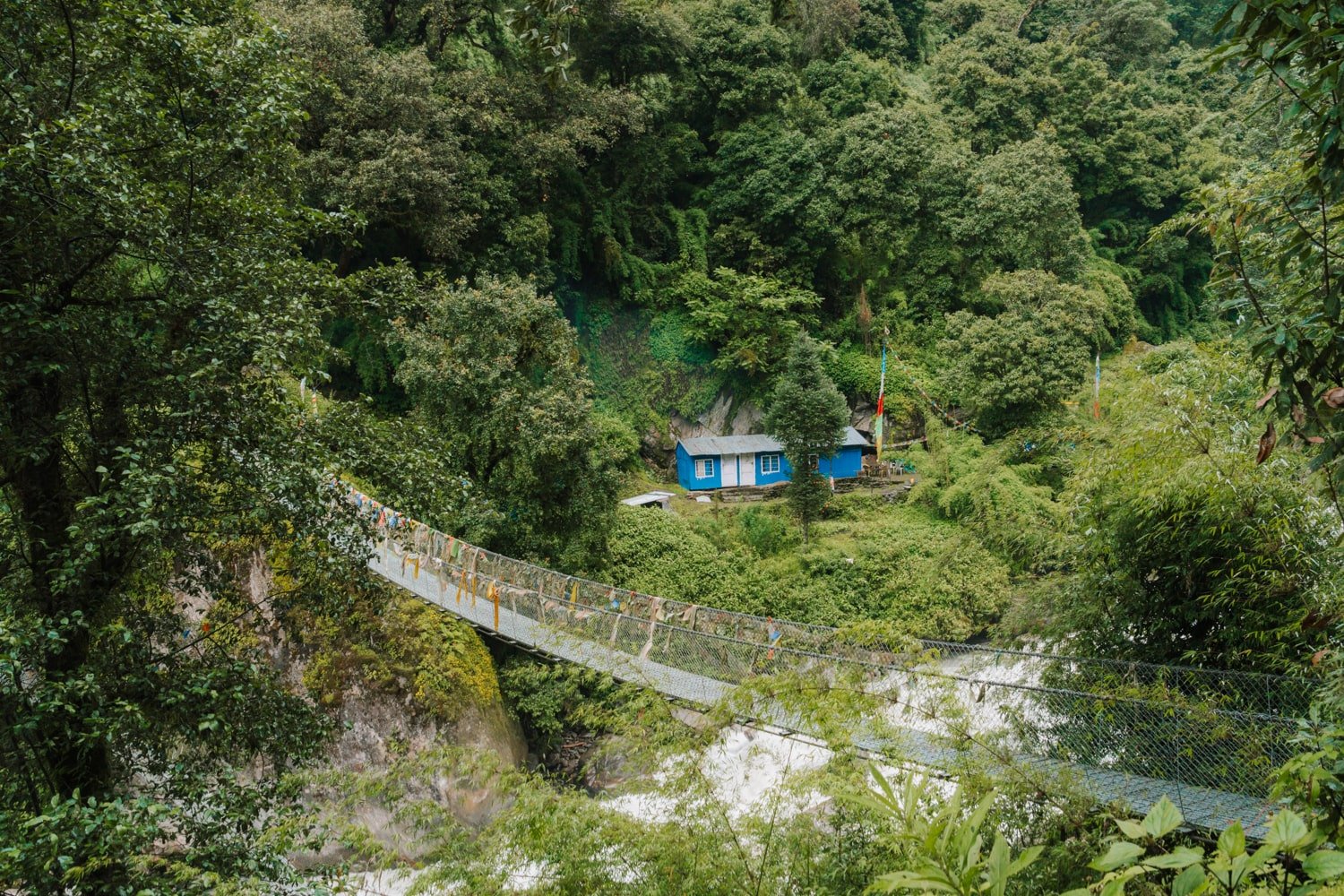
The last official day of your trek! As you already know the route, this day goes by pretty smoothly.
No surprise steep sections, just a few downhill ones and a scramble across the landslide-risk area by the river.
You’ll be back in “leech country” (season-depending) on this day, so keep that in mind with your clothes.
As the trek started, once you pass the first/last teahouse you’re back on the road until you reach Syabrubesi where you’ll spend the remainder of the afternoon and evening relaxing those sore muscles. 😃
Day 8: Syabrubesi to Kathmandu
- Route: Depart Syabrubesi by bus or private vehicle back to Kathmandu
- Time: 6-8 hours
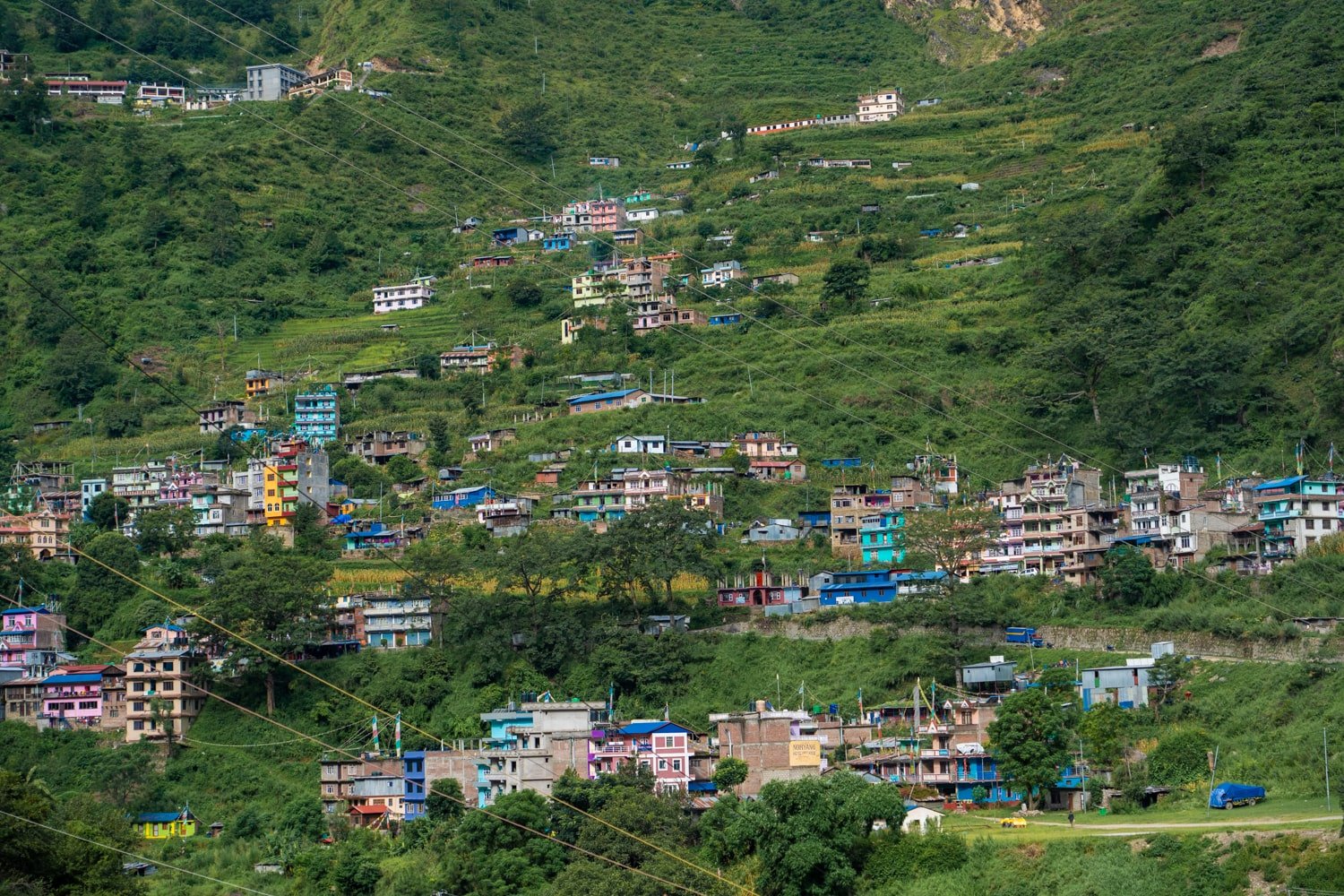
The bus from Syabrubesi back to Kathmandu doesn’t leave very early in the morning, from what we were told. So instead of waiting around, we ordered a private jeep/vehicle for our group (of 4) to get ahead of the traffic.
Going by private vehicle saved us so much time, we were able to get back to Kathmandu by early afternoon and not waste our day.
I think if I had a redo, I’d do the same: Bus from Ktm to Syabrubesi (since the time you arrive there doesn’t really matter as the trek starts the next day) and a private jeep for the way back from Syabrubesi to Kathmandu.
Either way, you’ll want to make arrangements beforehand so you’re not waiting around to snag a seat on a bus that doesn’t have any room.
I hope by sharing my experience in this complete guide to the Langtang Valley trek that you are able to better plan and make the most out of your trip!
Don’t hesitate to drop your lingering trekking questions below, and happy trekking!
<!–
–>



